When we first arrived in Dominica I took a walk along the main road in town to visit the market and spied this guy with an alarmingly large snake wrapped around his neck.
Separately, I had heard that there was someone living on the beach that salvaged wood in the rain forest from trees that had been knocked down during hurricane Maria that had so decimated the island.
It turned out to be the same guy and his name is Humty. I’m not positive about the spelling but it is pronounced (Hum-tee). He told me that he had found the snake in the bush while working. I wanted to learn more.  I had gotten a taste of some of the exotic hardwoods available on the island when we visited the chocolate factory and now wanted to see for myself, how the wood was salvaged. When I asked about how he cut logs into boards he told me that he just used his chainsaw and free-handed the log into boards. Now that I had to see…
I had gotten a taste of some of the exotic hardwoods available on the island when we visited the chocolate factory and now wanted to see for myself, how the wood was salvaged. When I asked about how he cut logs into boards he told me that he just used his chainsaw and free-handed the log into boards. Now that I had to see…
We agreed to meet the following morning, Sunday at 09:00 and head out. I had somehow assumed that he had a truck or at least access to one and I was surprised to see him hoist his saw, an alarming one with a blade of some 30″ long, up onto his shoulder and off we walked down the road. Along the way, and the walk on the road was about two miles, a friend of his stopped with a pickup truck and gave us a lift.
Before we headed into the forest we stopped at a small general store for something to drink if we became thirsty. I got a bottle of water and Humty, a beer. So off we walked into the bush, Humty with this huge saw on his shoulder and beer in the other hand. Oh yeah, and he had a ganja cigarette in his lips. And, don’t forget that it was still early on a Sunday morning, a sort of double fisted hair of the dog, I guess.
I can’t say that I had ever thought of beer, “local herbs” and a chainsaw were a great combination, especially first thing on a Sunday morning. Oh yeah, I almost forgot, he also had a long and quite menacing looking machete. 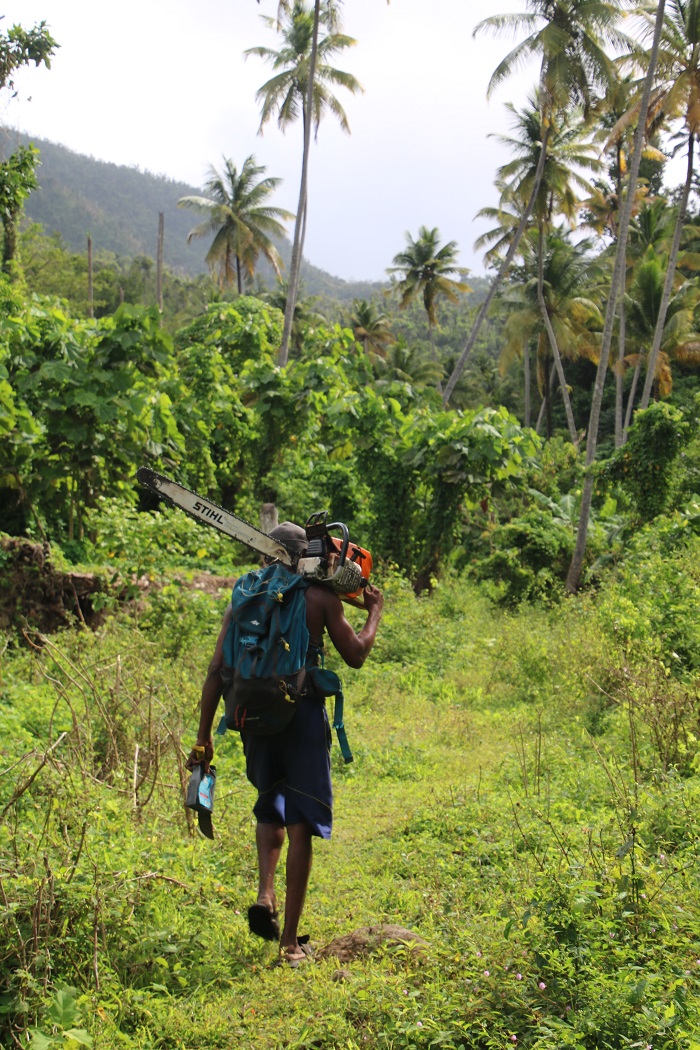 Over the years, I had seen portable sawmills that can turn a log into boards using a really long chainsaw that was guided by rails and other equipment that made the cuts quite precise but the idea of someone cutting logs into boards by eye and a steady hand was something I found hard to imagine.
Over the years, I had seen portable sawmills that can turn a log into boards using a really long chainsaw that was guided by rails and other equipment that made the cuts quite precise but the idea of someone cutting logs into boards by eye and a steady hand was something I found hard to imagine.
We didn’t have to go very far into the bush but after perhaps a half mile we crossed a small stream and found our way into a clearing with huge downed trees scattered here and there. In the clearing some locals had planted a large number of what I learned were coffee tree seedlings along with banana plants. 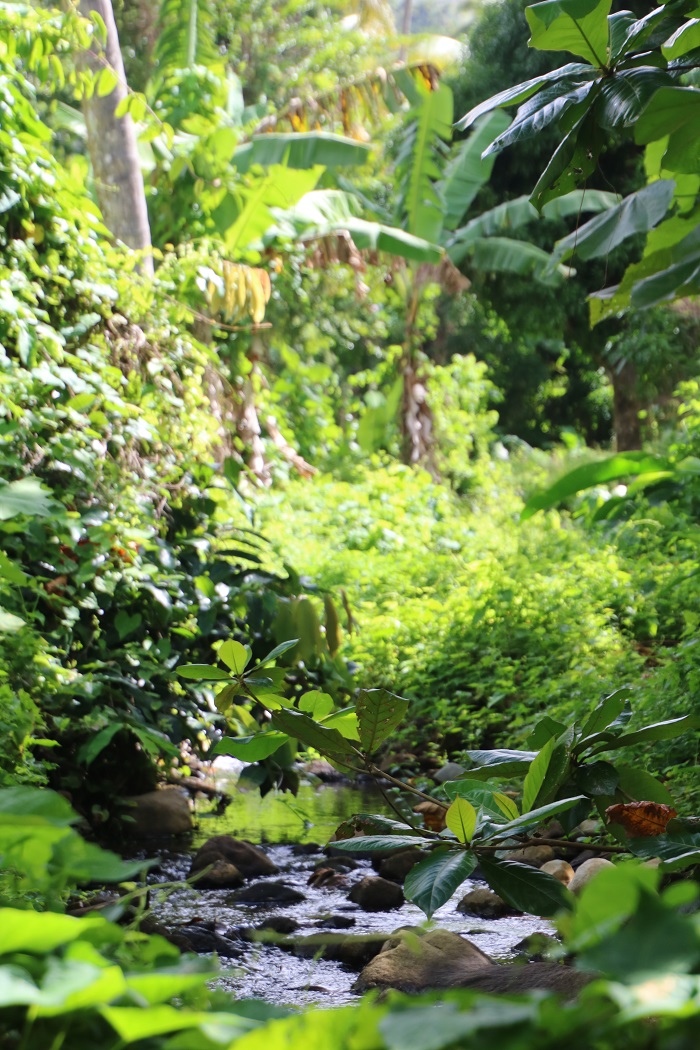 Humty selected a promising log, some 20″ in diameter and sat down to sharpen his saw, one tooth at a time with a round file. 30 minutes later he was ready to make his first cut.
Humty selected a promising log, some 20″ in diameter and sat down to sharpen his saw, one tooth at a time with a round file. 30 minutes later he was ready to make his first cut. 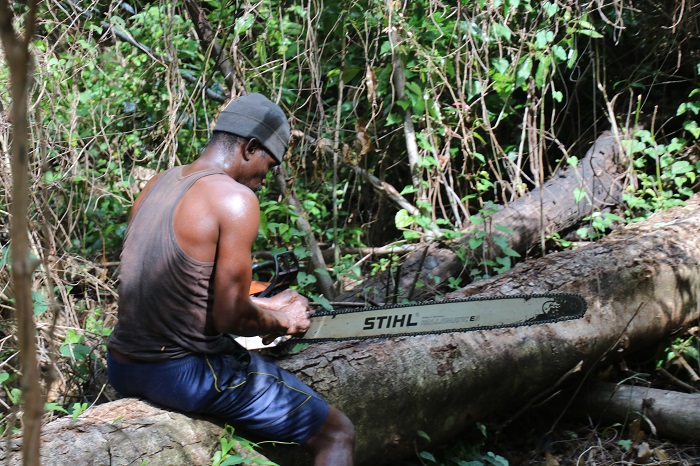 Then he marked the log to a bit over 5′ and removed a section. His newly sharpened saw went through it like soft balsa.
Then he marked the log to a bit over 5′ and removed a section. His newly sharpened saw went through it like soft balsa. 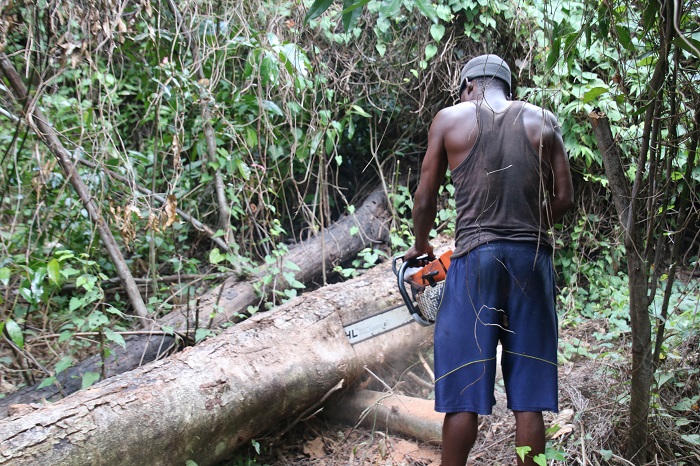 After rolling the newly cut log onto a base of smaller logs and bracing it up against a small tree, he proceeded to carefully run his saw down the length of the log, marking it for the individual boards he planned to cut, each about 1 1/4″ thick. The cuts were more precise than this photo suggests.
After rolling the newly cut log onto a base of smaller logs and bracing it up against a small tree, he proceeded to carefully run his saw down the length of the log, marking it for the individual boards he planned to cut, each about 1 1/4″ thick. The cuts were more precise than this photo suggests.  He began at the end of the log closest to him and progressively drew the saw from end to end, each cut only a fraction of an inch deeper than the last.
He began at the end of the log closest to him and progressively drew the saw from end to end, each cut only a fraction of an inch deeper than the last. 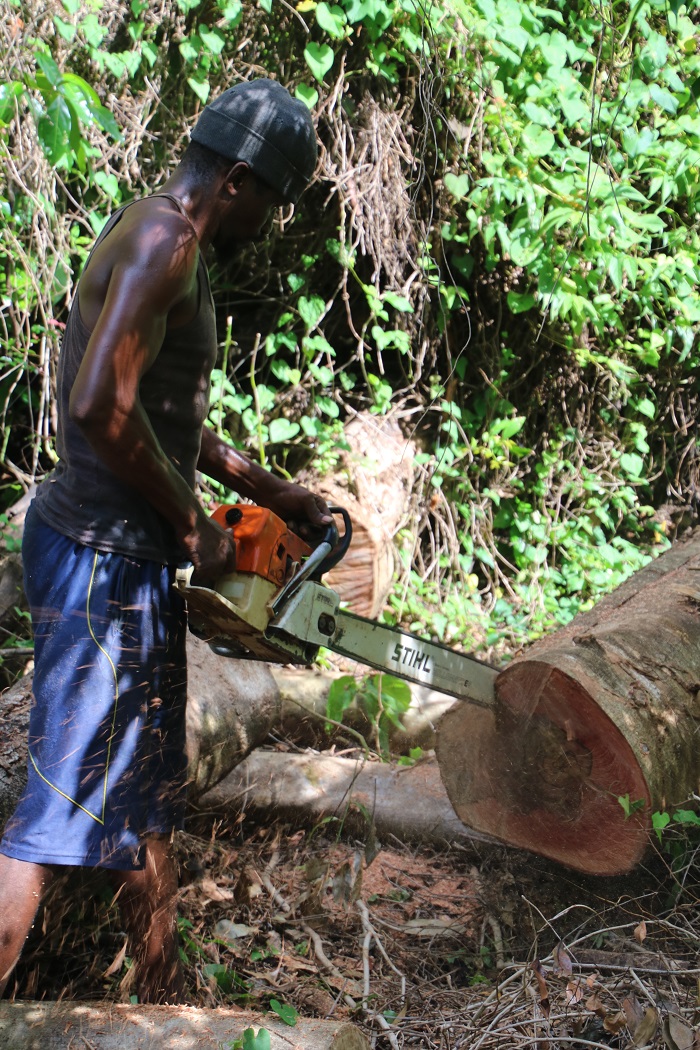 Beginning on the left, after marking all of the boards, he slowly cut deeper and deeper until the board was only supported at the far end by a small uncut wedge of wood.
Beginning on the left, after marking all of the boards, he slowly cut deeper and deeper until the board was only supported at the far end by a small uncut wedge of wood. 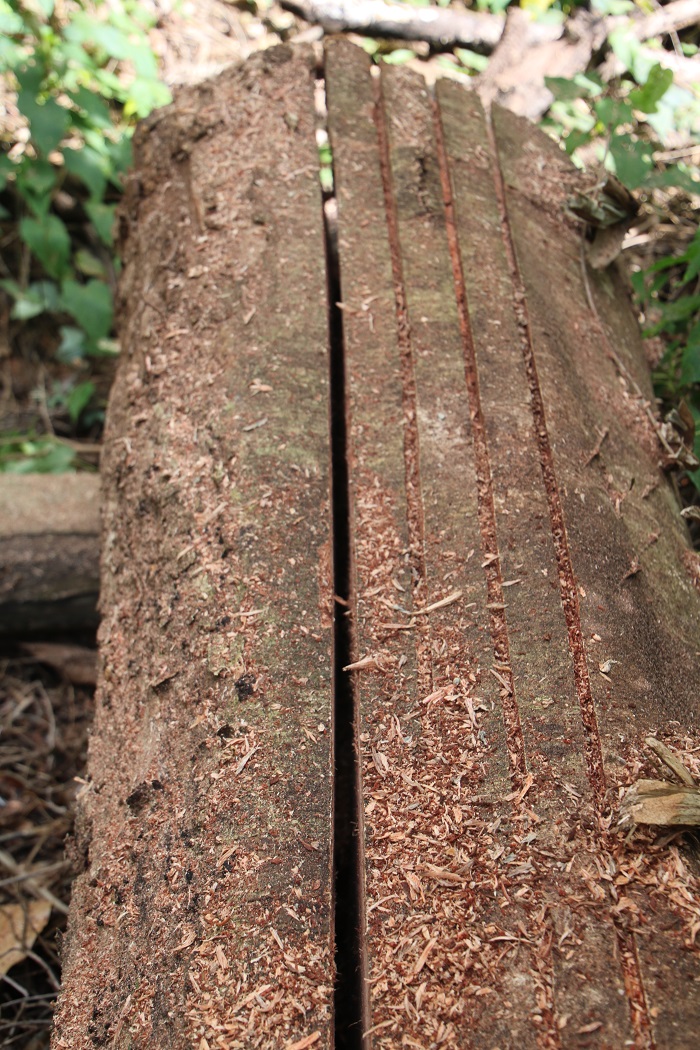 The process of cutting all the way through the log, end to end, took more than two hours and in the end he had three boards. He paused once to resharpen his saw, a few gulps of beer and puffs.
The process of cutting all the way through the log, end to end, took more than two hours and in the end he had three boards. He paused once to resharpen his saw, a few gulps of beer and puffs.
All the time the noise of the saw was deafening but no hearing protection needed. I suppose that to someone who uses a huge chainsaw with shorts and open toe sandals isn’t all that concerned about hearing loss. However, after twenty years of this sort of work, he still has all of his fingers and toes.
Meanwhile a small lizard watched from a distance as Humty did his work. 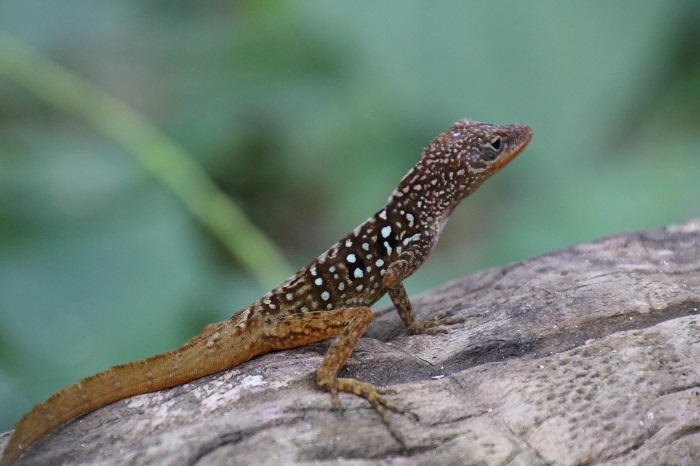 He paused from time to time to check his measurements.
He paused from time to time to check his measurements.  As one cut was mostly finished he moved onto the next, from left to right.
As one cut was mostly finished he moved onto the next, from left to right.
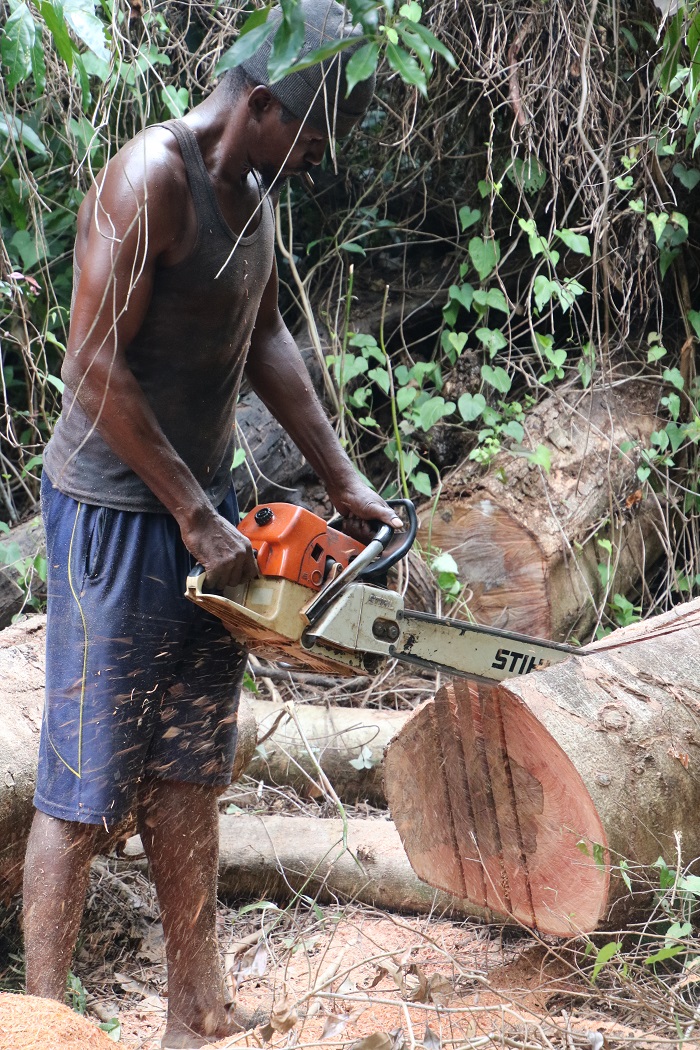 Once the four cuts were complete with only a small sliver of uncut wood on the end of each board he made the final cut, beginning on the left and the boards fell away.
Once the four cuts were complete with only a small sliver of uncut wood on the end of each board he made the final cut, beginning on the left and the boards fell away. 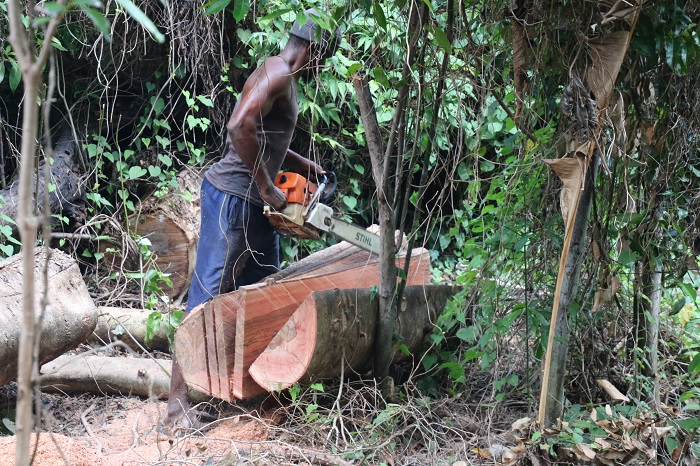 These finished cuts were remarkably consistent and all done by eye.
These finished cuts were remarkably consistent and all done by eye. 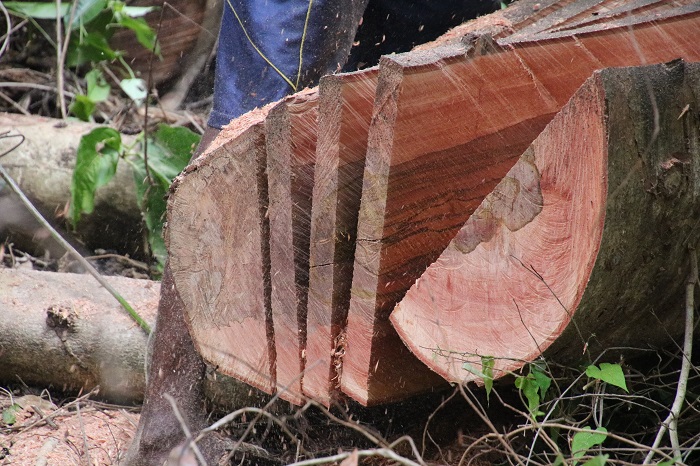 What was left of the log could have yielded a few more boards but I had asked for three so that’s what he cut.
What was left of the log could have yielded a few more boards but I had asked for three so that’s what he cut. 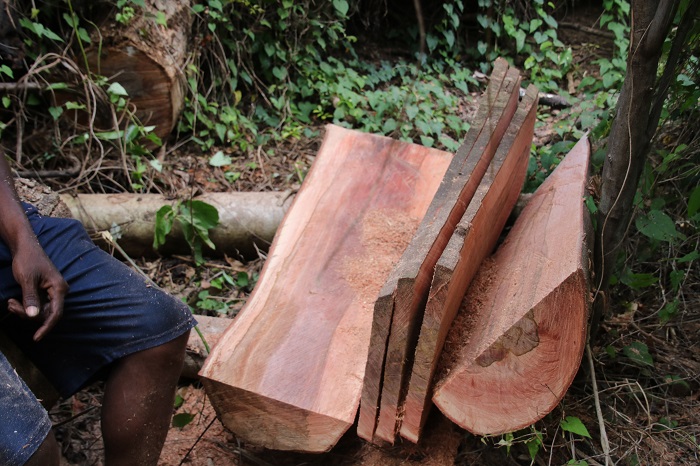 The boards have beautiful figuring.
The boards have beautiful figuring. 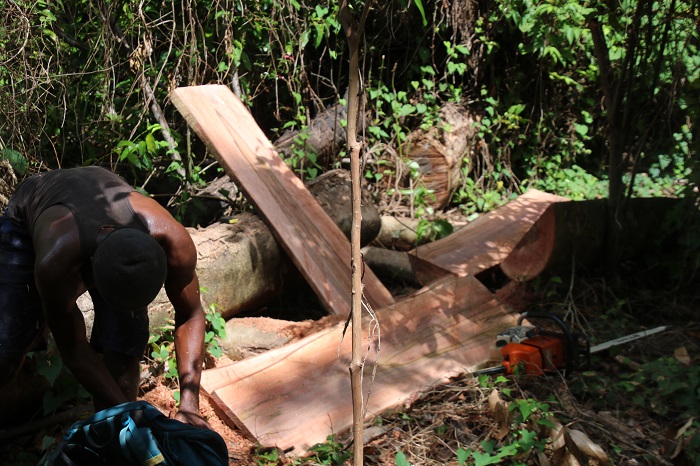 The dark markings are not water staining or rot, it’s the way the trees grow. Notice how smooth the cuts are. You would never know that he had just held the saw and cut them freehand.
The dark markings are not water staining or rot, it’s the way the trees grow. Notice how smooth the cuts are. You would never know that he had just held the saw and cut them freehand.  I have no idea what I will make these boards into but they are remarkable and I’ve never seen anything like it. The wood is very dense and HEAVY.
I have no idea what I will make these boards into but they are remarkable and I’ve never seen anything like it. The wood is very dense and HEAVY.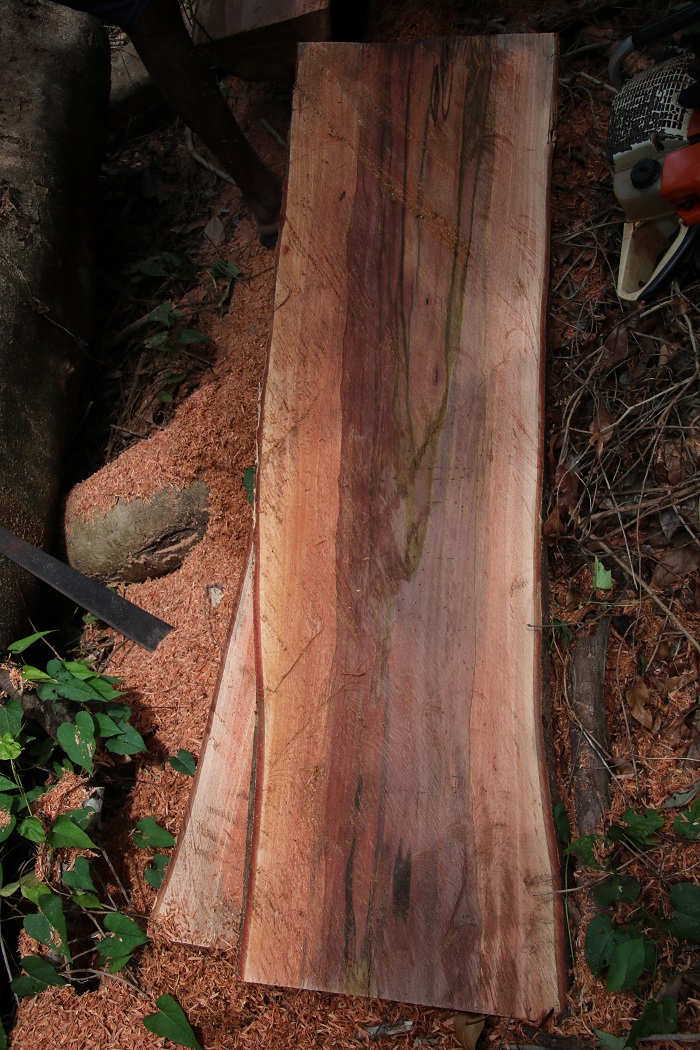 Even though the wood had fallen nearly three years ago, there was not rot but OMG, they are heavy, perhaps 70lbs each.
Even though the wood had fallen nearly three years ago, there was not rot but OMG, they are heavy, perhaps 70lbs each.
Humty, in spite of their weight, hoisted each board and held it over his head, with the saw in the other hand and carried them out. He enlisted a friend to help carry the final board out. 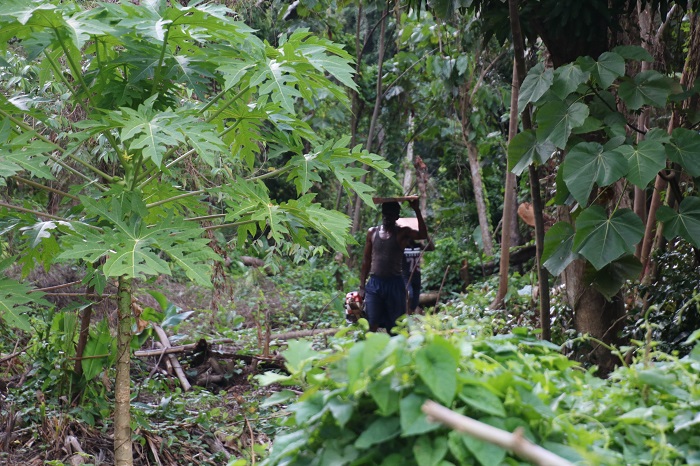 He didn’t miss a beat as he forded down into the stream and up the other side.
He didn’t miss a beat as he forded down into the stream and up the other side. 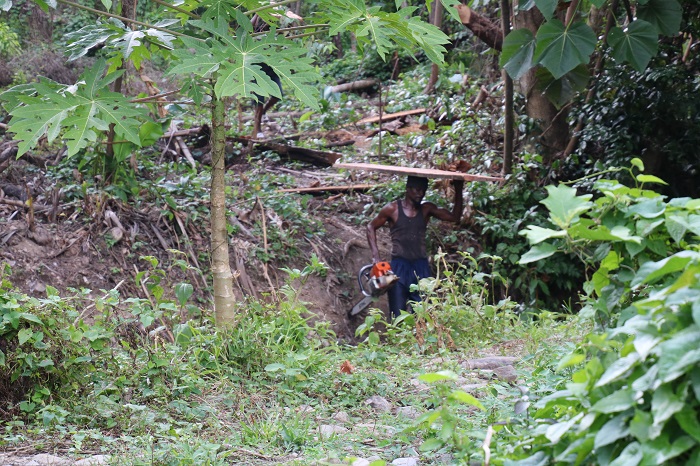 As I write this we are now in Martinique and for the time being, the boards are still at Humty’s home on the beach. I am hoping that they will dry out a bit so that they aren’t quite so heavy and I’ll need time to think about how I am going to secure a few hundred pounds of boards down below the cockpit. I sure don’t want them to come loose along the way as I can only imagine what sort of damage they would do if they started crashing around making a mess of my autopilot and who knows what else when the going gets rough on the trip home, which it always does.
As I write this we are now in Martinique and for the time being, the boards are still at Humty’s home on the beach. I am hoping that they will dry out a bit so that they aren’t quite so heavy and I’ll need time to think about how I am going to secure a few hundred pounds of boards down below the cockpit. I sure don’t want them to come loose along the way as I can only imagine what sort of damage they would do if they started crashing around making a mess of my autopilot and who knows what else when the going gets rough on the trip home, which it always does.
So there you have it, a guy named Humty, his snake, an alarming saw and don’t forget a beer to get in the mood along with a bit of ganja.
You just can’t make this stuff up.

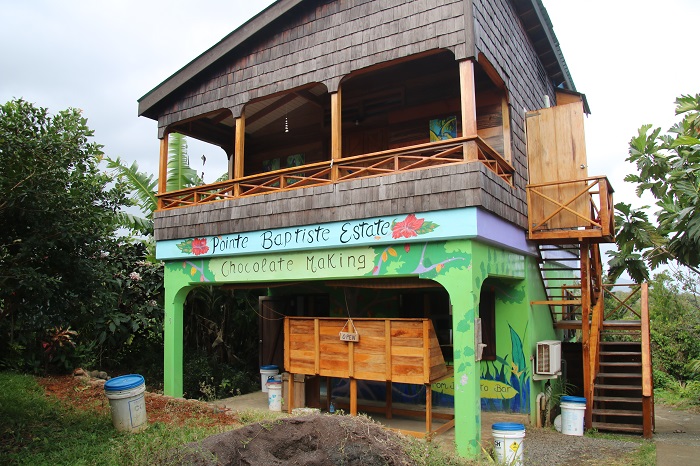 This little family run business makes terrific chocolate, all of which is sold here on the island. a total of 2,000 lbs per year, in many creative flavors.
This little family run business makes terrific chocolate, all of which is sold here on the island. a total of 2,000 lbs per year, in many creative flavors. They grow cocoa beans and coffee on the property. This is what a raw cocoa seed pod looks like. The white soft material is sweet and covers the cocoa beans, each pod has a cluster of beans inside.
They grow cocoa beans and coffee on the property. This is what a raw cocoa seed pod looks like. The white soft material is sweet and covers the cocoa beans, each pod has a cluster of beans inside. 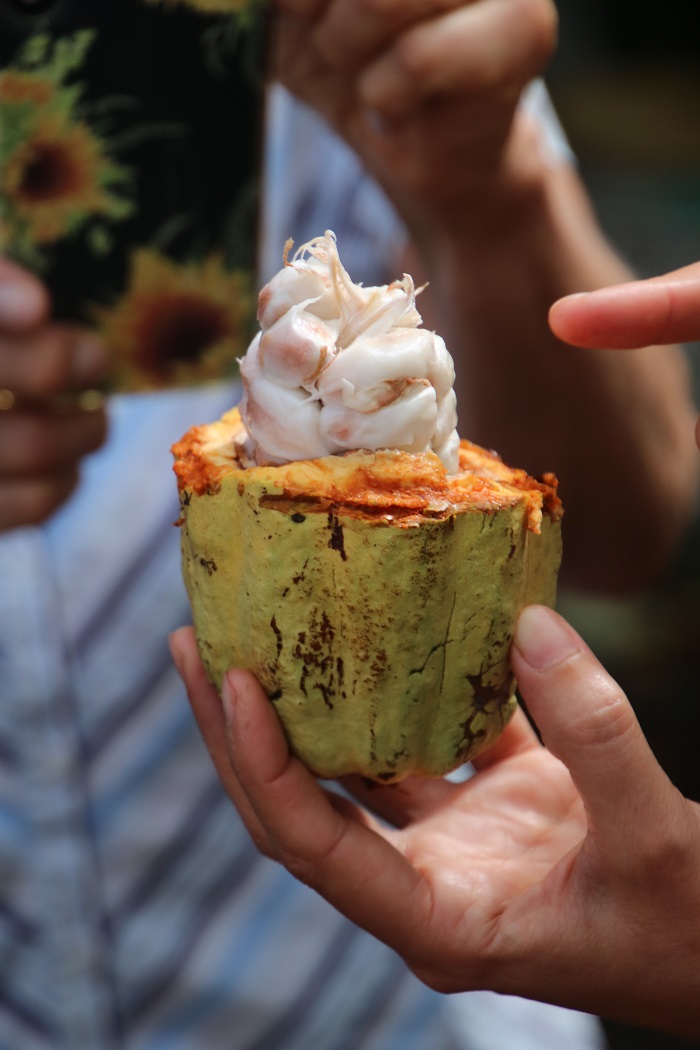 The wet raw beans are put into these wooden bins, covered with banana leaves where they are left to ferment for a several days.
The wet raw beans are put into these wooden bins, covered with banana leaves where they are left to ferment for a several days. 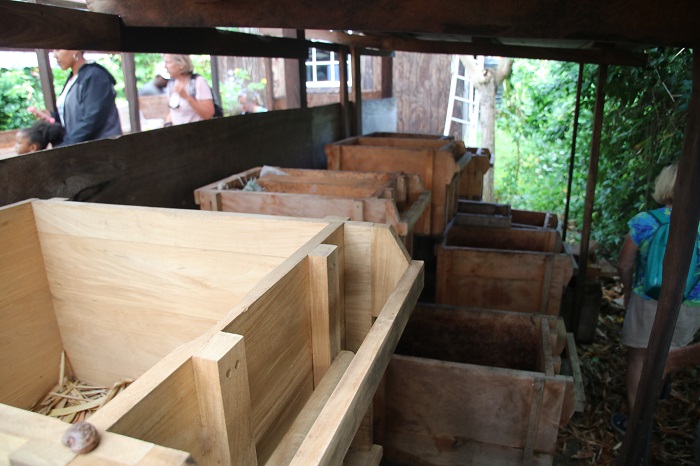 The beans are then separated from any liquid from the fermentation and spread to dry on open racks.
The beans are then separated from any liquid from the fermentation and spread to dry on open racks.  The dry but still raw beans are about 1/2″ long and already smell like chocolate.
The dry but still raw beans are about 1/2″ long and already smell like chocolate. 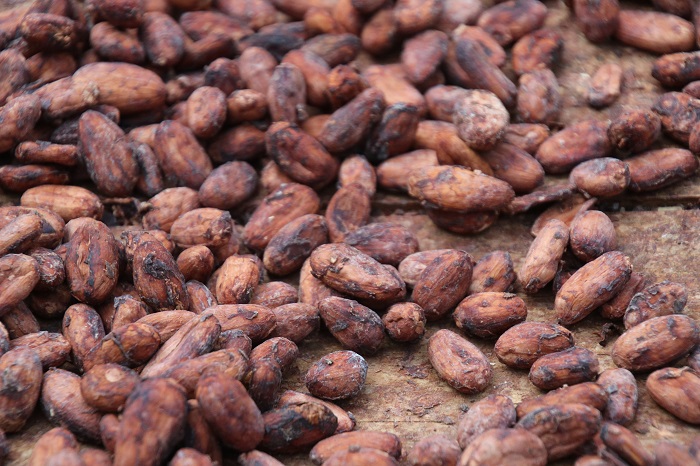 Then the beans are roasted in a special oven at, I think, 250 degrees F.
Then the beans are roasted in a special oven at, I think, 250 degrees F.  While the process is fairly primitive, it is carefully controlled by modern equipment. I wonder if the “emergency stop” button sets off an alarm meant to keep someone from eating too much chocolate? Hmm…
While the process is fairly primitive, it is carefully controlled by modern equipment. I wonder if the “emergency stop” button sets off an alarm meant to keep someone from eating too much chocolate? Hmm… After roasting the beans are roughly cracked to separate the outer hull from the meat of the bean.
After roasting the beans are roughly cracked to separate the outer hull from the meat of the bean. 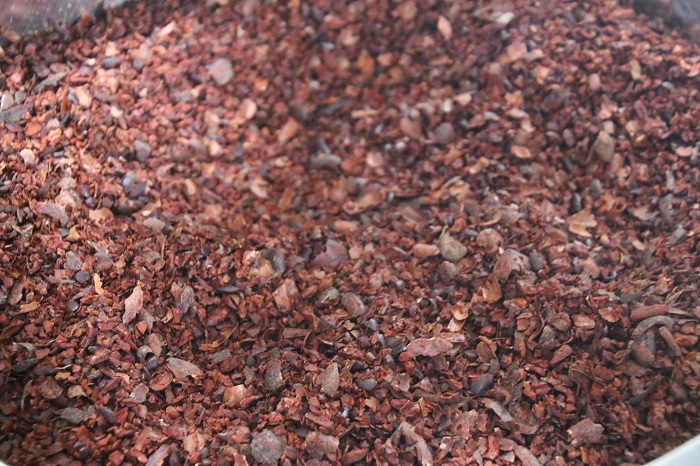 Then they are put into this machine, where air is blown into the pipe, the force of air carrying the lighter husks up and away, separating, as you might say, “The wheat from the chaff”. It’s simple and ingenious and effective. The “good” stuff, which is heavier, falls into the black bin and the “chaff” goes up the tube and down into the white bucket.
Then they are put into this machine, where air is blown into the pipe, the force of air carrying the lighter husks up and away, separating, as you might say, “The wheat from the chaff”. It’s simple and ingenious and effective. The “good” stuff, which is heavier, falls into the black bin and the “chaff” goes up the tube and down into the white bucket. 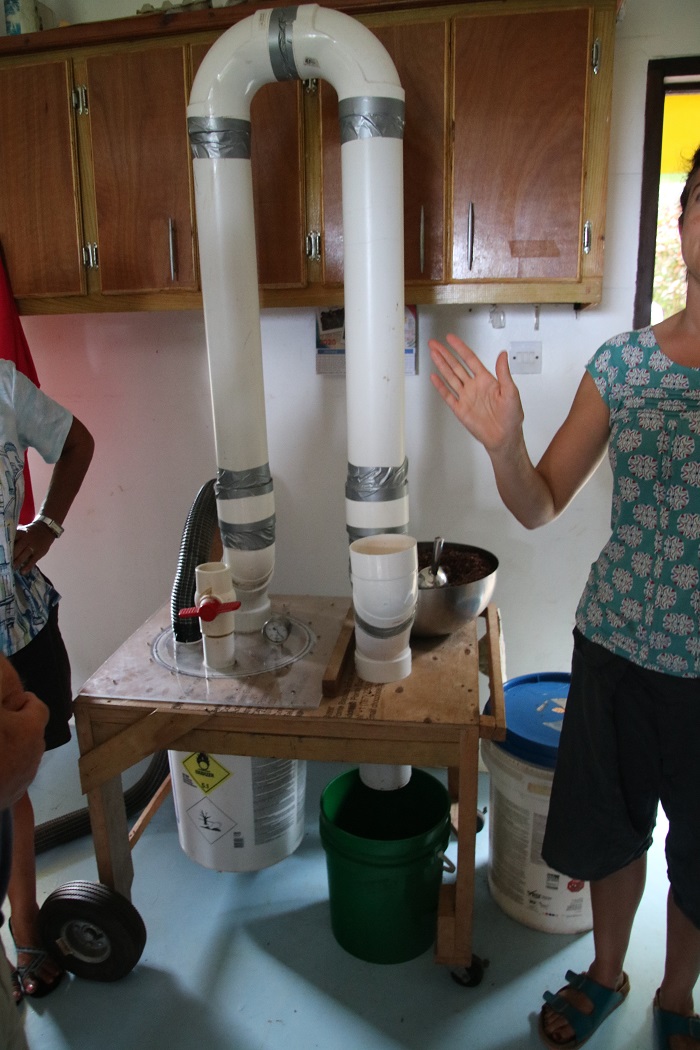 Next the “cleaned” beans are ground into a rough paste by rollers that turn around in the bucket. At this point, they really smell like chocolate.
Next the “cleaned” beans are ground into a rough paste by rollers that turn around in the bucket. At this point, they really smell like chocolate. An additional step puts the chocolate into an even finer grinder/roller that smooths things out into a very smooth paste. Finally, depending on the particular flavor that is planned, they mix in the appropriate amount of cane sugar and any flavoring that might be needed, like ginger or hot pepper, two examples. Then the mixture is poured into molds to harden, prior to packaging and labeling.
An additional step puts the chocolate into an even finer grinder/roller that smooths things out into a very smooth paste. Finally, depending on the particular flavor that is planned, they mix in the appropriate amount of cane sugar and any flavoring that might be needed, like ginger or hot pepper, two examples. Then the mixture is poured into molds to harden, prior to packaging and labeling. 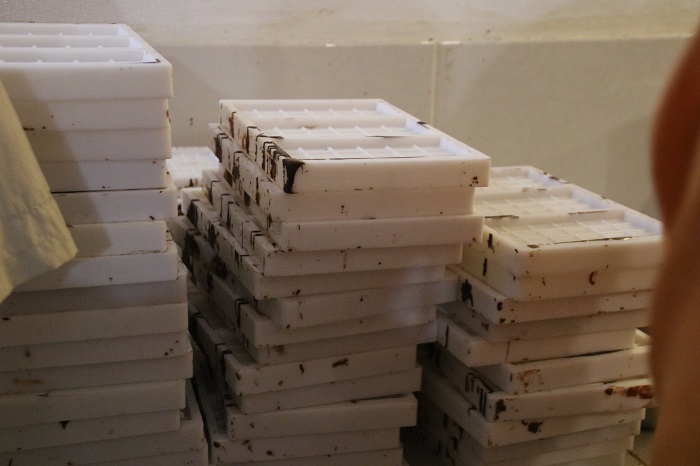 They produce many flavors and we tried nearly all of them. Hungry for more? Unless you are in Dominca, or good friends with Brenda, your’e out of luck as their product is only available on the island. Of course, you too can take a tour as they happily welcome visitors.
They produce many flavors and we tried nearly all of them. Hungry for more? Unless you are in Dominca, or good friends with Brenda, your’e out of luck as their product is only available on the island. Of course, you too can take a tour as they happily welcome visitors. 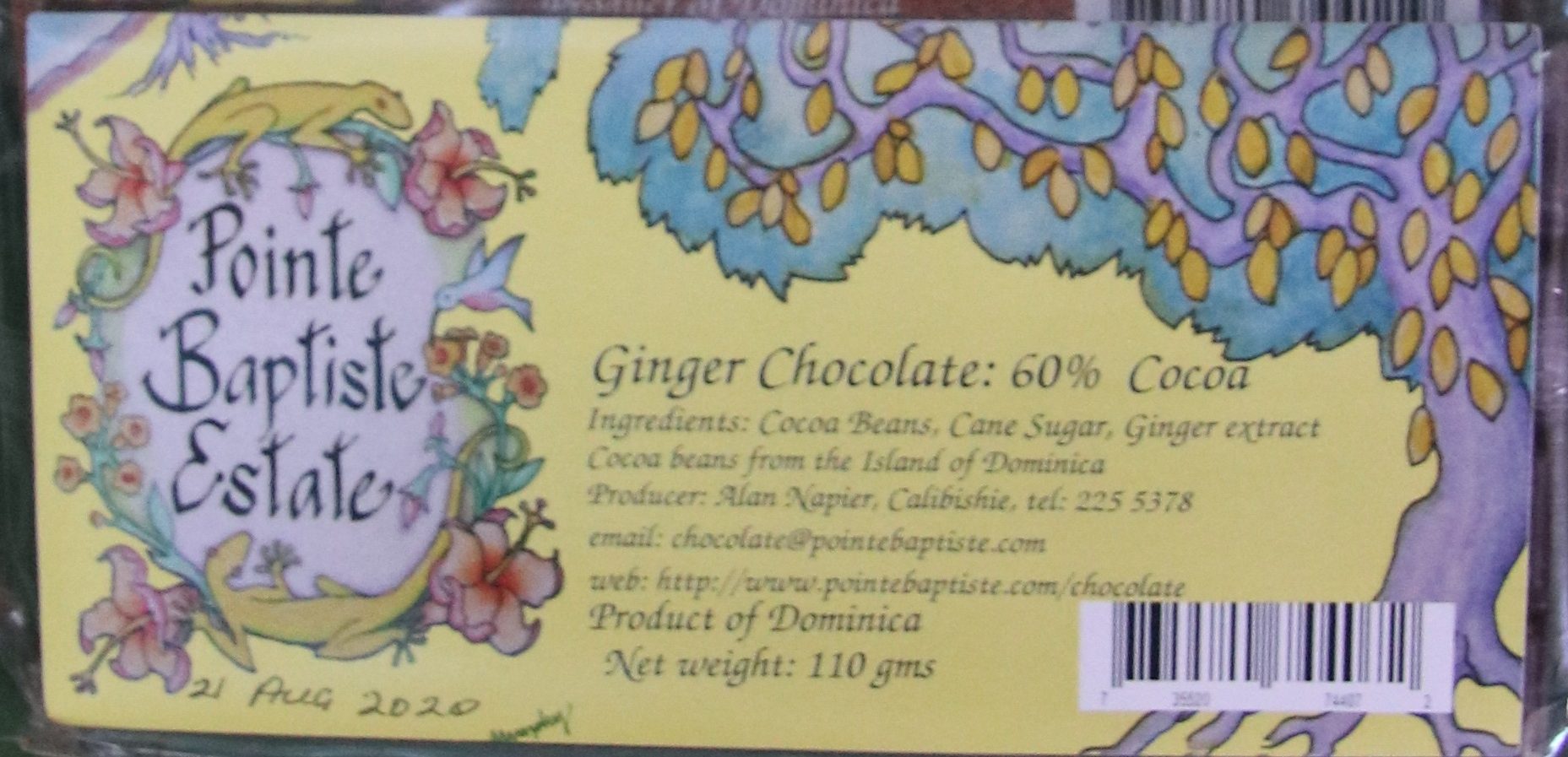 This chocolate is very much “home made” as the father/daughter owners have actually built a home above the “factory” where she lives with her boyfriend. I was quite taken by the design of the house and tropical woods used in the construction, wood that was cut from trees knocked down during the hurricane.
This chocolate is very much “home made” as the father/daughter owners have actually built a home above the “factory” where she lives with her boyfriend. I was quite taken by the design of the house and tropical woods used in the construction, wood that was cut from trees knocked down during the hurricane.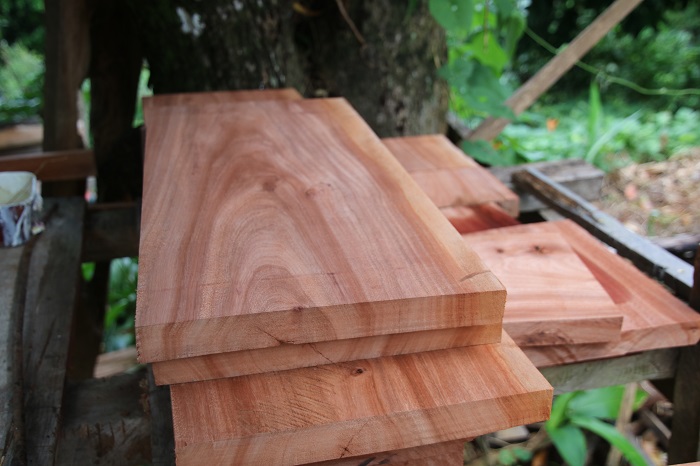 After hearing of my interest in the wood and how he built his home, I was invited up to take a look inside. It was like visiting an enchanted tree house in the forest.
After hearing of my interest in the wood and how he built his home, I was invited up to take a look inside. It was like visiting an enchanted tree house in the forest.  A very nice functional kitchen.
A very nice functional kitchen. 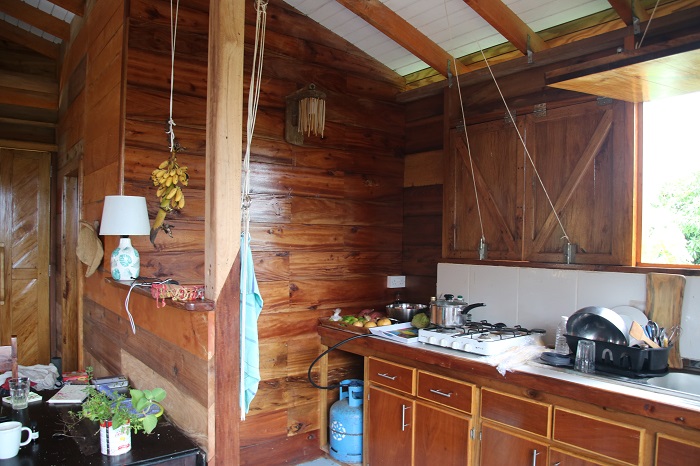 And a spectacular view of the ocean in the distance.
And a spectacular view of the ocean in the distance.  What a wonderful spot. If you ever get an opportunity to visit, I recommend you do. A small business living off of the land and yet respectful of the forest which sort of sums up things here in Dominca, the nature island.
What a wonderful spot. If you ever get an opportunity to visit, I recommend you do. A small business living off of the land and yet respectful of the forest which sort of sums up things here in Dominca, the nature island.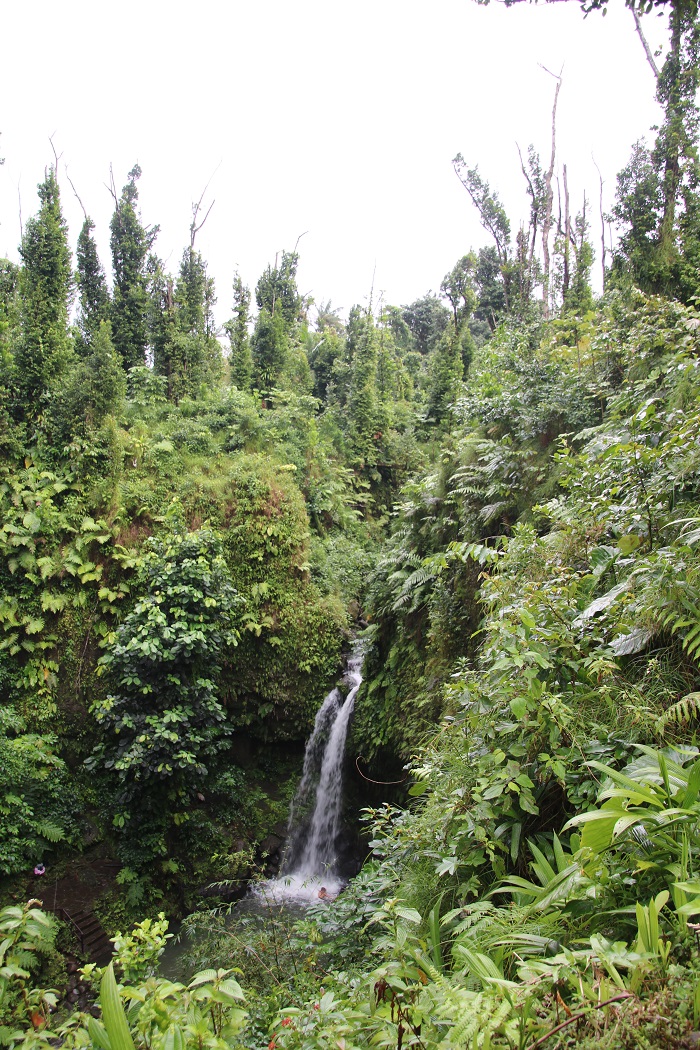 I am always struck by the lush plants of all kinds. This tree ern “fiddle head” is much larger than it looks, the thickness of a broom handle.
I am always struck by the lush plants of all kinds. This tree ern “fiddle head” is much larger than it looks, the thickness of a broom handle. 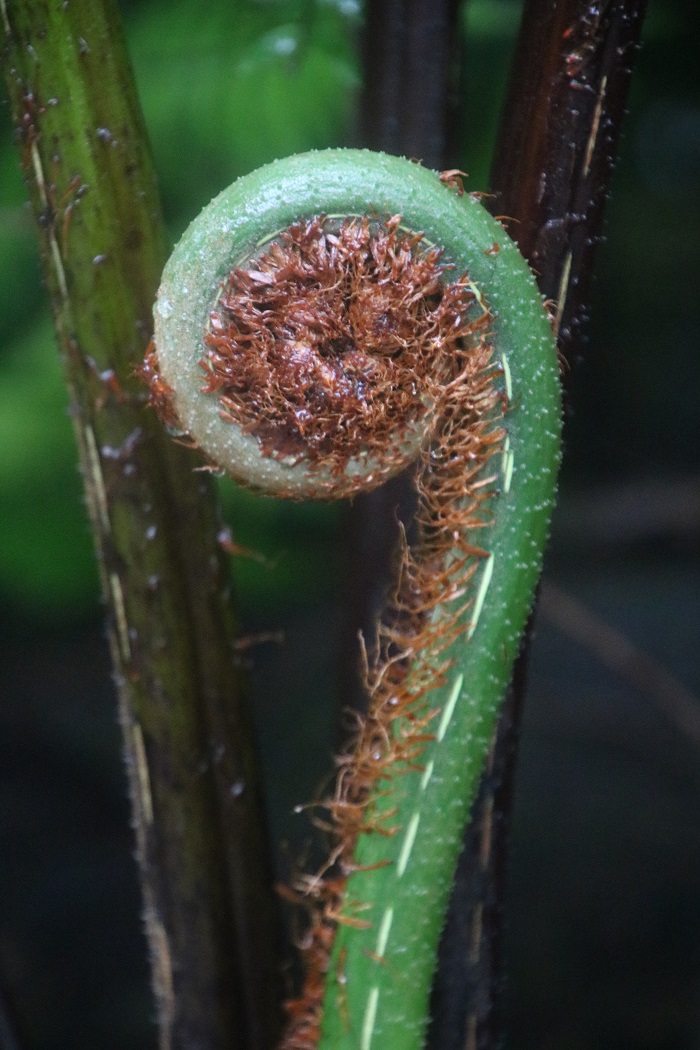 The path to the pool meanders a short distance past rapids to an observation area and then you are there.
The path to the pool meanders a short distance past rapids to an observation area and then you are there.  The water, while not “martini” cold, will make you catch your breath when you dip in, is a lot cooler than the surrounding air as it thunders down into the pool.
The water, while not “martini” cold, will make you catch your breath when you dip in, is a lot cooler than the surrounding air as it thunders down into the pool.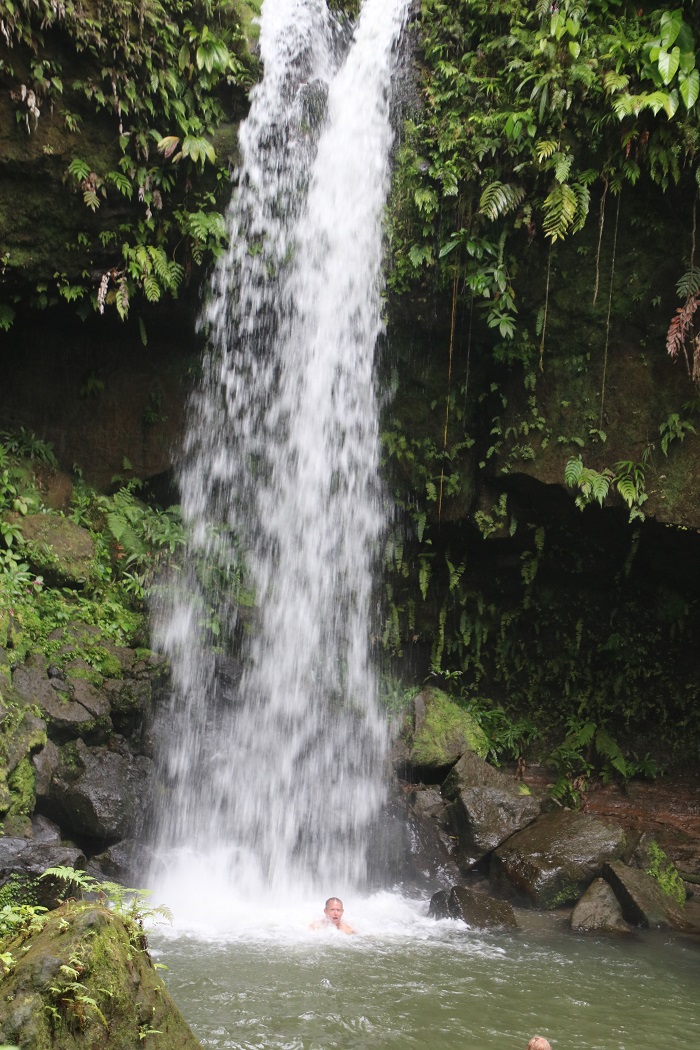 Maureen, can you hear me now? What?
Maureen, can you hear me now? What? My friend Bill, looked like he was thinking about auditioning for a part in Pirates of the Caribbean, much of which was filmed on the island. Unlike many of the cruisers on the French boats, Bill is wearing a bathing suit. At least I think he is. Bill? Hard to tell…
My friend Bill, looked like he was thinking about auditioning for a part in Pirates of the Caribbean, much of which was filmed on the island. Unlike many of the cruisers on the French boats, Bill is wearing a bathing suit. At least I think he is. Bill? Hard to tell…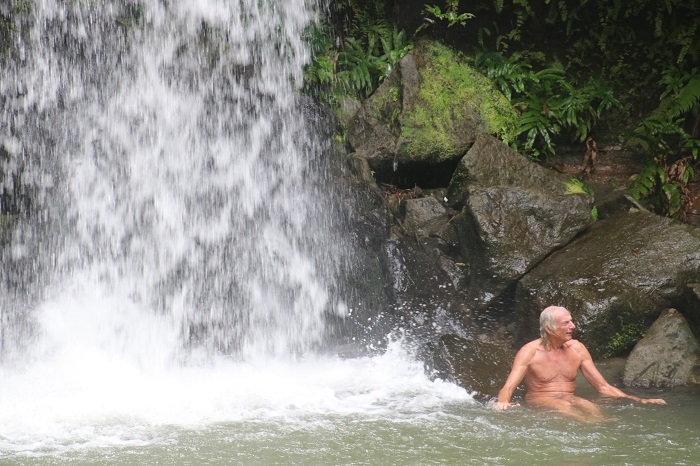 As you would expect, where there are mountains and lots of water, there is hydro power. This setup, with a large pipe running vertically down a cliff, powers a small turbine generator. And, with some 300″ of rainfall each year, there is a constant supply of water to run the turbines.
As you would expect, where there are mountains and lots of water, there is hydro power. This setup, with a large pipe running vertically down a cliff, powers a small turbine generator. And, with some 300″ of rainfall each year, there is a constant supply of water to run the turbines.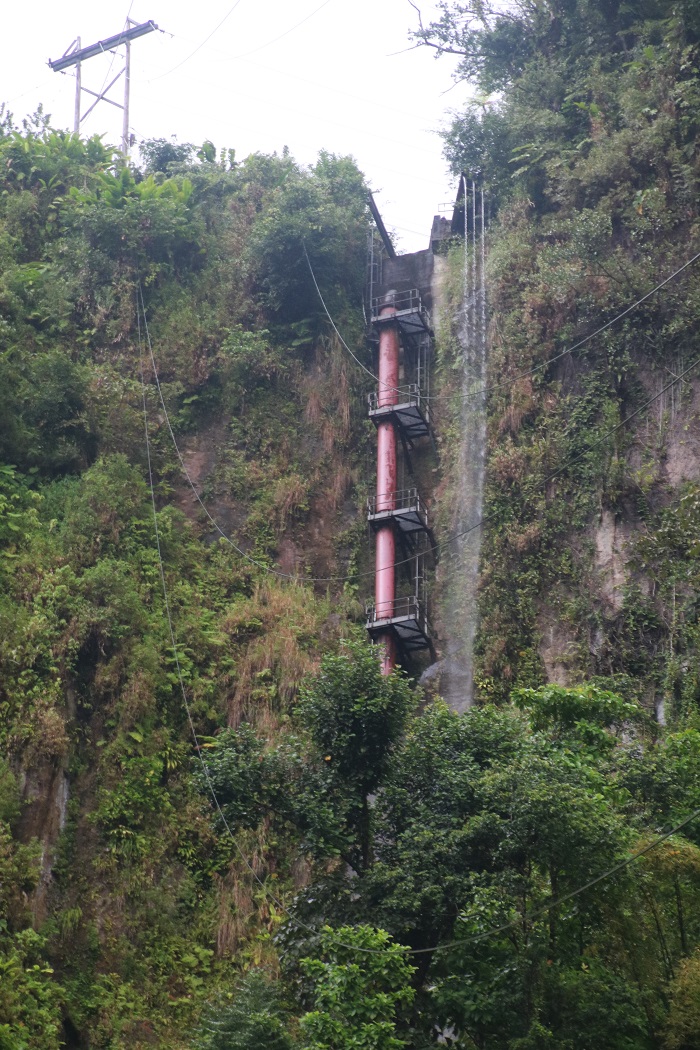 Unfortunately, in spite of the abundant sunshine, wind and water, only about 1/4 of the energy produced on Dominica is renewable. Hopefully, this will increase in the coming years.
Unfortunately, in spite of the abundant sunshine, wind and water, only about 1/4 of the energy produced on Dominica is renewable. Hopefully, this will increase in the coming years.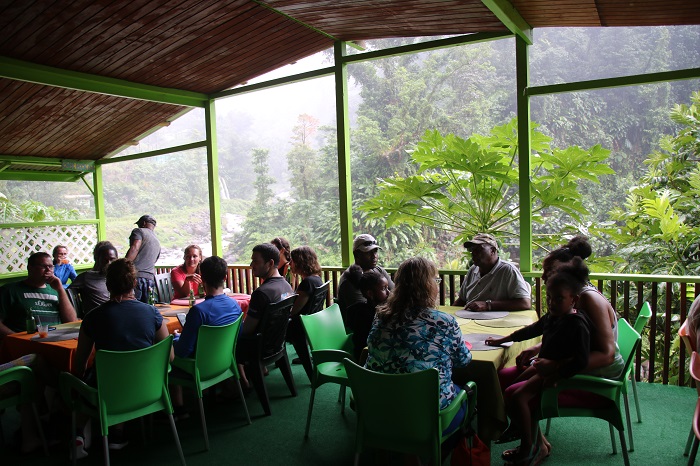 In the distance you can see the double exit spouts from the hydro generator.
In the distance you can see the double exit spouts from the hydro generator. 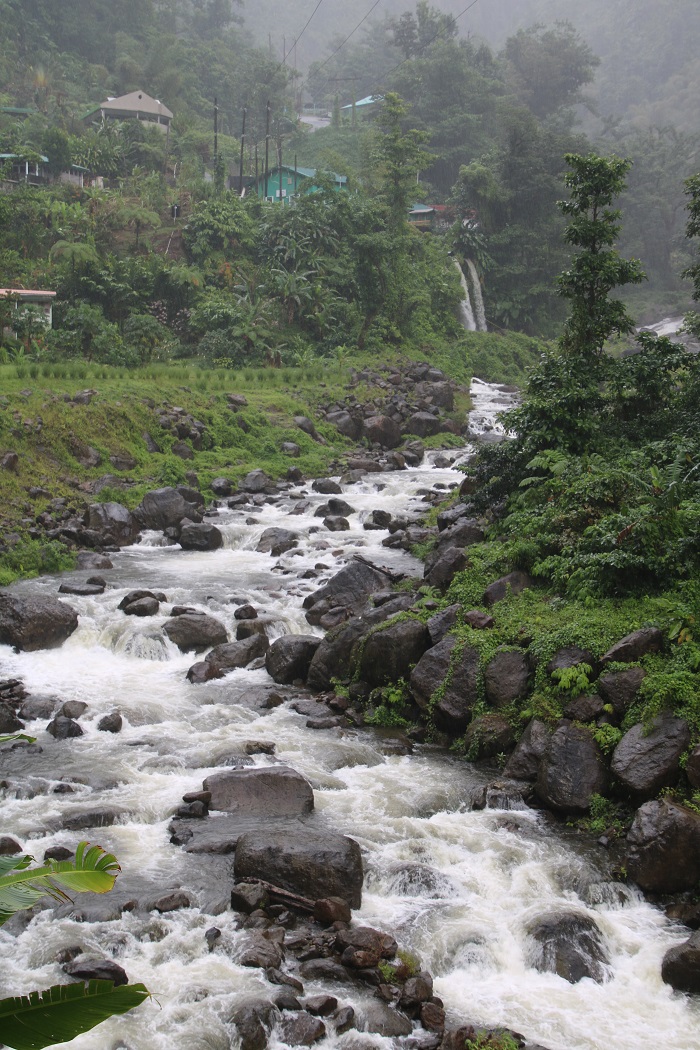 Ok, so our last stop of the day, and by this time we had driven around 3/4 of the island, was a natural hot spring. The charming spot was run by a local family and tapped into naturally hot springs. The island has a number of active volcanoes and what they call “boiling lakes” where the water coming out of the ground is so hot, it boils.
Ok, so our last stop of the day, and by this time we had driven around 3/4 of the island, was a natural hot spring. The charming spot was run by a local family and tapped into naturally hot springs. The island has a number of active volcanoes and what they call “boiling lakes” where the water coming out of the ground is so hot, it boils.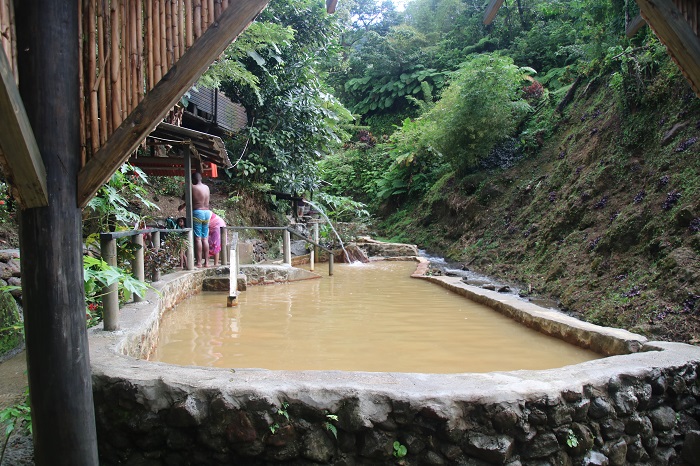 There were three pools, each progressively smaller, and each with water that was a bit hotter but still a good temperature for a tropical mountain soak. As we were up in the mountains, where the air was cooler, it felt good to be in the warm water. You can see the spout that is pouring warm/hot water into the pool. The water was almost to hot to touch and quite murky. I didn’t want to think to hard about what sort of “bugs” might be growing in the pool. However, the pools were not crowded and had a good amount of water flowing into them so I guess it was ok. No odd skin lesions yet… Bill, Maureen? Any boils breaking out? Brenda?
There were three pools, each progressively smaller, and each with water that was a bit hotter but still a good temperature for a tropical mountain soak. As we were up in the mountains, where the air was cooler, it felt good to be in the warm water. You can see the spout that is pouring warm/hot water into the pool. The water was almost to hot to touch and quite murky. I didn’t want to think to hard about what sort of “bugs” might be growing in the pool. However, the pools were not crowded and had a good amount of water flowing into them so I guess it was ok. No odd skin lesions yet… Bill, Maureen? Any boils breaking out? Brenda?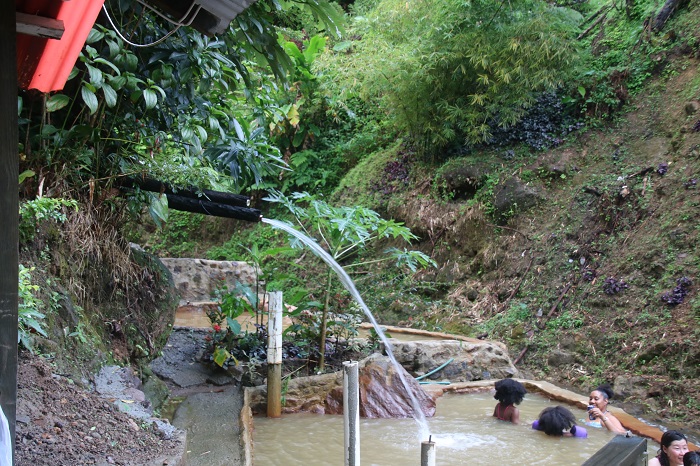 All and all, we had a wonderful day and even though we were visiting some of the most popular spots on the islands, they weren’t crowded. No surprise on an island with only about 600 hotel rooms.
All and all, we had a wonderful day and even though we were visiting some of the most popular spots on the islands, they weren’t crowded. No surprise on an island with only about 600 hotel rooms. This harbor, Portsmouth Dominica, is on the very north west part of the island and while it is wide open to the west, like most harbors in the Windwards, it is wonderfully protected from the strong trade winds and waves and as the wind comes out of the east for about 99% of the time.
This harbor, Portsmouth Dominica, is on the very north west part of the island and while it is wide open to the west, like most harbors in the Windwards, it is wonderfully protected from the strong trade winds and waves and as the wind comes out of the east for about 99% of the time.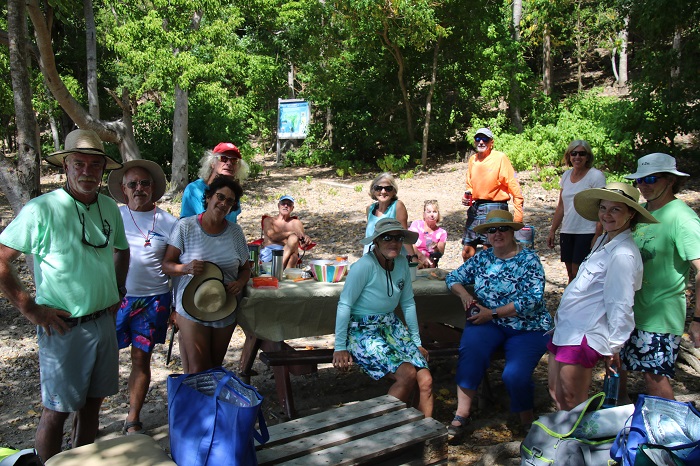 And, speaking of “flocks”, I spied this growing family when I visited the local bakery to pick up come baguettes the other day. I can’t imagine chickens wandering around a restaurant in the US.
And, speaking of “flocks”, I spied this growing family when I visited the local bakery to pick up come baguettes the other day. I can’t imagine chickens wandering around a restaurant in the US. 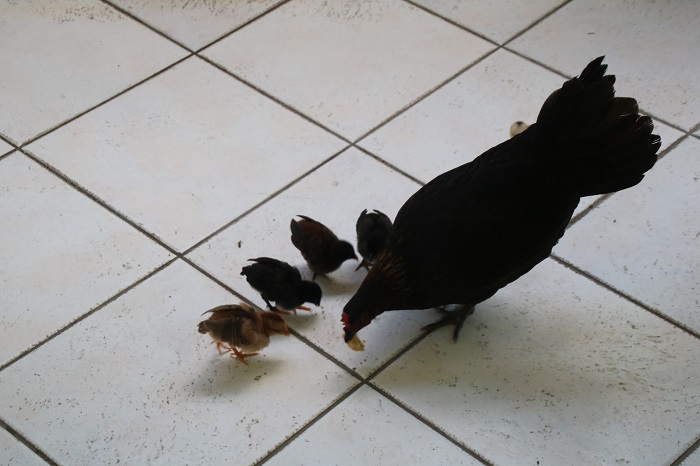 And, of course, where there a chicks, there are roosters.
And, of course, where there a chicks, there are roosters.  The views along the beach are very colorful with homes and boats are painted bright, happy colors.
The views along the beach are very colorful with homes and boats are painted bright, happy colors.
 We see flags from many countries. Do you know where this one is from? Flags that are black and white are very rare. I believe that only two countries have flags that are this color. Double gold stars if you know the name of both countries or, and this is a hint, the flag of a region of a particular country.
We see flags from many countries. Do you know where this one is from? Flags that are black and white are very rare. I believe that only two countries have flags that are this color. Double gold stars if you know the name of both countries or, and this is a hint, the flag of a region of a particular country.  A few days ago, I went ashore to check out the tiny town here in Dominica and was impressed with the locally made baskets. In the interest of full disclosure, I was also looking for ice cream. Success on both counts.
A few days ago, I went ashore to check out the tiny town here in Dominica and was impressed with the locally made baskets. In the interest of full disclosure, I was also looking for ice cream. Success on both counts.  Brenda and I returned to the shop the next day. She ended up buying an exquisitely made one at another store. Along with all that she does, Brenda is also a very accomplished basket maker.
Brenda and I returned to the shop the next day. She ended up buying an exquisitely made one at another store. Along with all that she does, Brenda is also a very accomplished basket maker.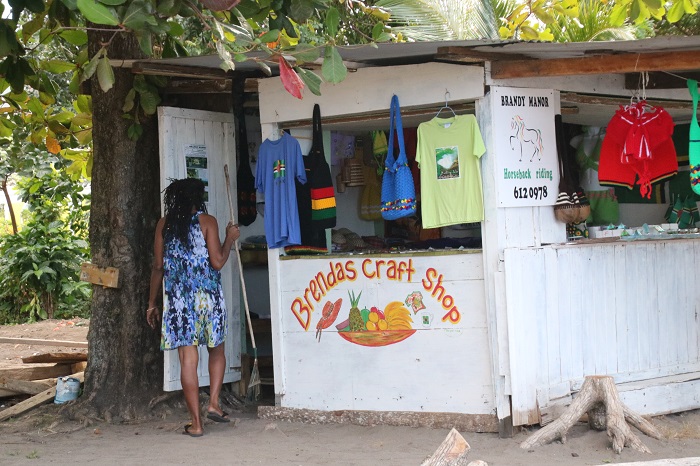 Anyway, I expect that we will be here in Dominica for at least a week the trades are up and it’s even rougher in the ocean than it was when we arrived here from Les Saintes, with seas running at nearly 10′. When the weather router, Chris Parker, describes conditions as “very salty”, Brenda, in particular, feel that it’s best to stay put.
Anyway, I expect that we will be here in Dominica for at least a week the trades are up and it’s even rougher in the ocean than it was when we arrived here from Les Saintes, with seas running at nearly 10′. When the weather router, Chris Parker, describes conditions as “very salty”, Brenda, in particular, feel that it’s best to stay put.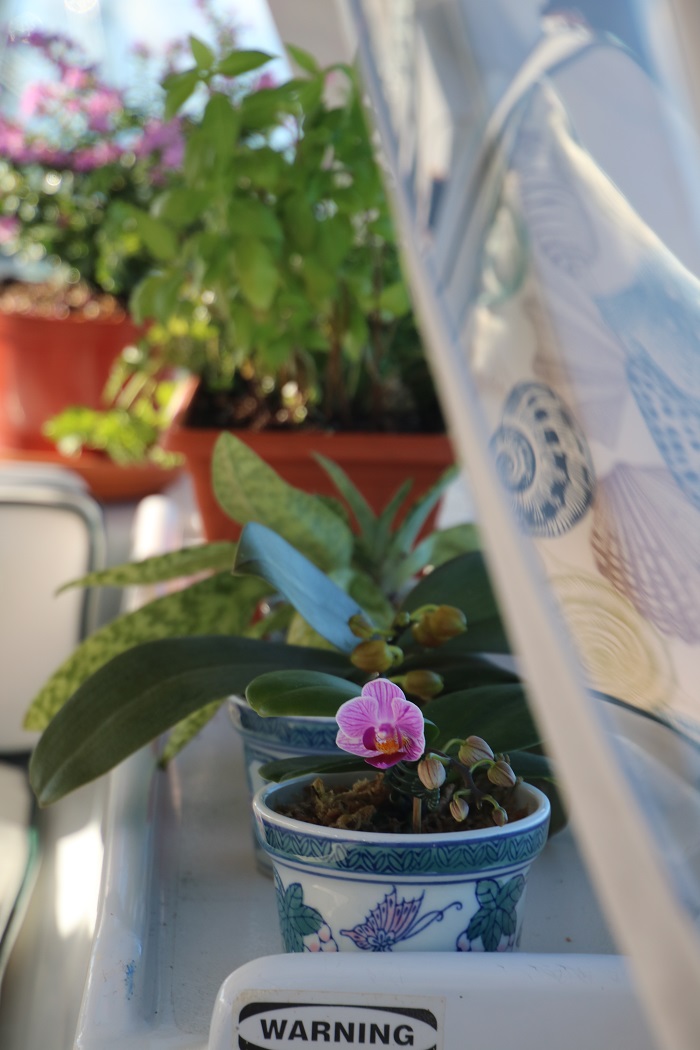 Pandora’s hard dodger can be a bit hot when the winds are calm which is almost never and offers a welcome respite from the strong tropical sunshine. Brenda took this shot, while I made coffee down below, as we made our way south along the west coast of Guadeloupe on our way to Les Saints the other day. In the lee of the island the waters are very calm and the wind, not so much.
Pandora’s hard dodger can be a bit hot when the winds are calm which is almost never and offers a welcome respite from the strong tropical sunshine. Brenda took this shot, while I made coffee down below, as we made our way south along the west coast of Guadeloupe on our way to Les Saints the other day. In the lee of the island the waters are very calm and the wind, not so much. 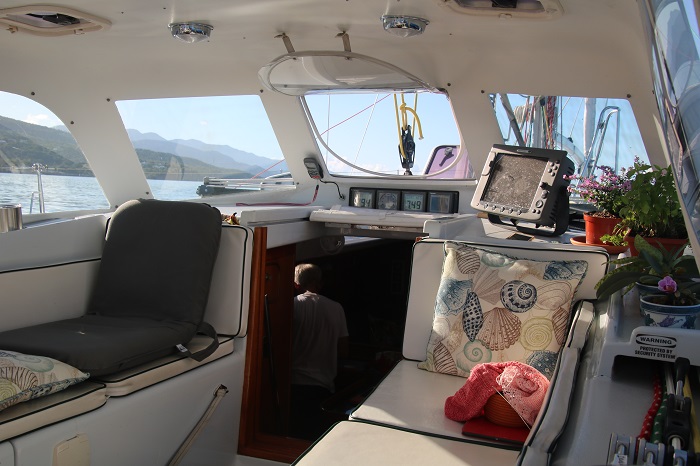 The view of Deshais from our stern shows how tiny the cove really is, with a lone sailboat just peaking out, more of an indent, than a harbor.
The view of Deshais from our stern shows how tiny the cove really is, with a lone sailboat just peaking out, more of an indent, than a harbor. 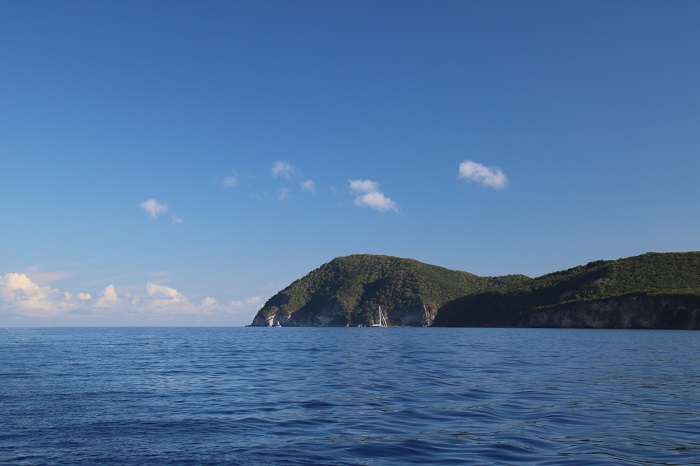 And the mountains of Guadeloupe in the morning haze to the south were beautiful.
And the mountains of Guadeloupe in the morning haze to the south were beautiful. 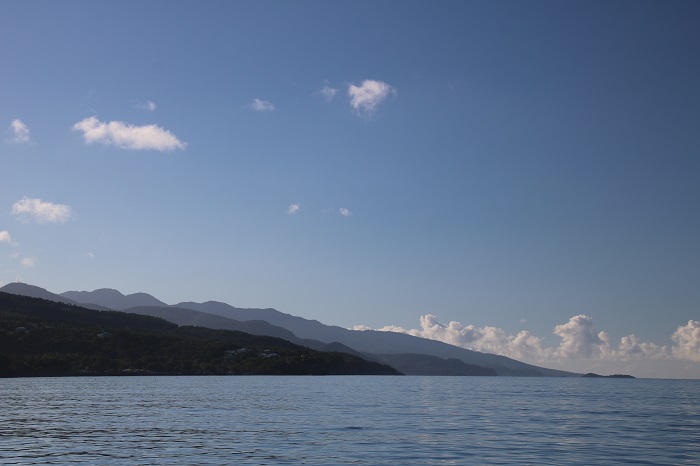 Here in Les Saintes we spend some time most days hunting for groceries, a rewarding effort as there is a remarkable selection of wonderful French food to choose from, and many places to purchase fresh bread,
Here in Les Saintes we spend some time most days hunting for groceries, a rewarding effort as there is a remarkable selection of wonderful French food to choose from, and many places to purchase fresh bread, 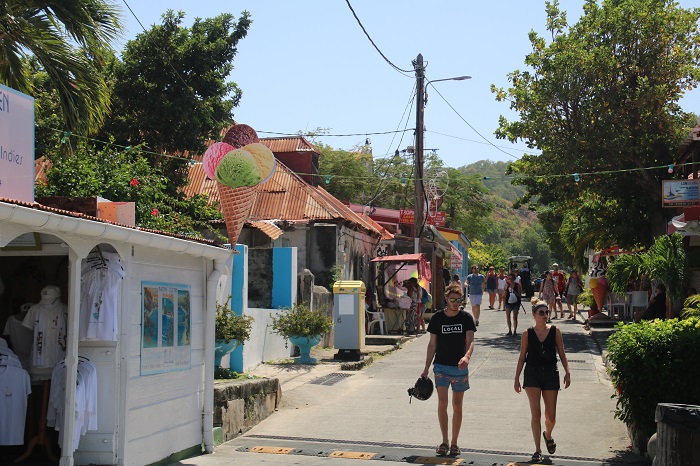 The waterfront is so charming with a very convenient dock to pull up our dink.
The waterfront is so charming with a very convenient dock to pull up our dink. 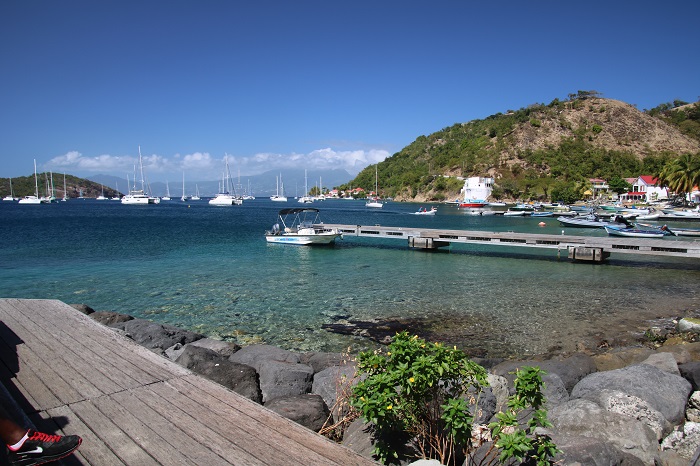 The waterfront looks like a tiny little village on the Mediterranean.
The waterfront looks like a tiny little village on the Mediterranean. 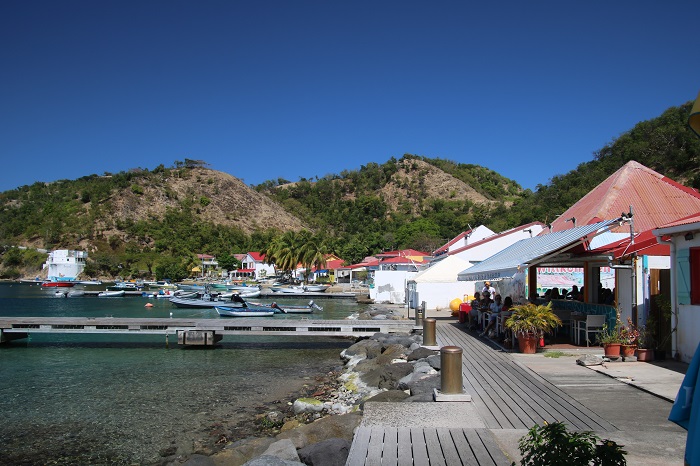 Every view better than the last.
Every view better than the last. 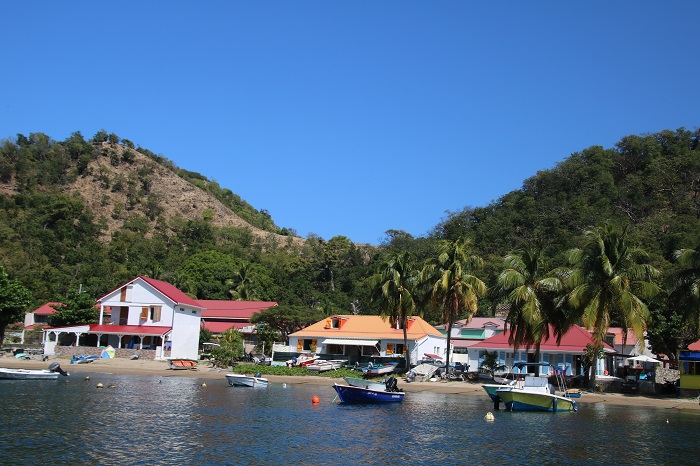 The
The 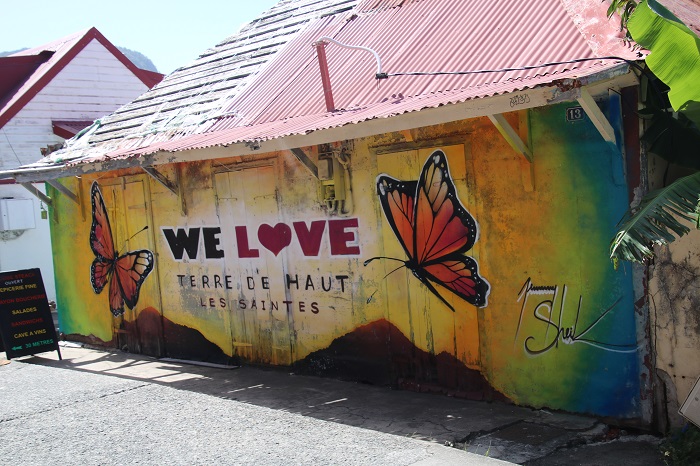 There are plenty of reasonably priced places to enjoy a terrific French meal.
There are plenty of reasonably priced places to enjoy a terrific French meal. 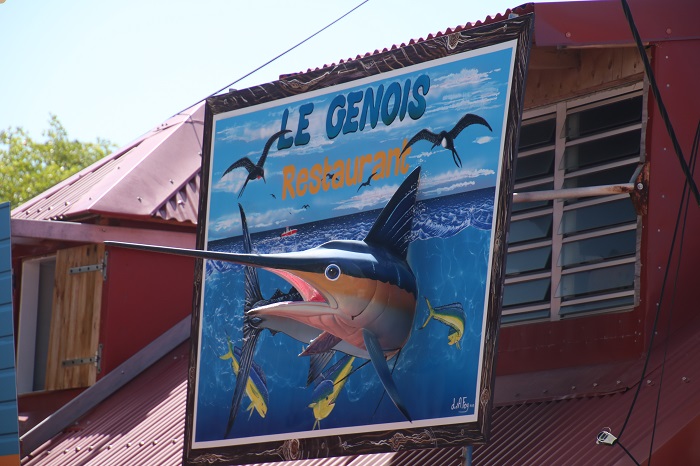 Last evening we went out for dinner with our friends Mark and Lynn from Roxy and had an amazing dinner of fois gras and lamb chops. Yum.
Last evening we went out for dinner with our friends Mark and Lynn from Roxy and had an amazing dinner of fois gras and lamb chops. Yum.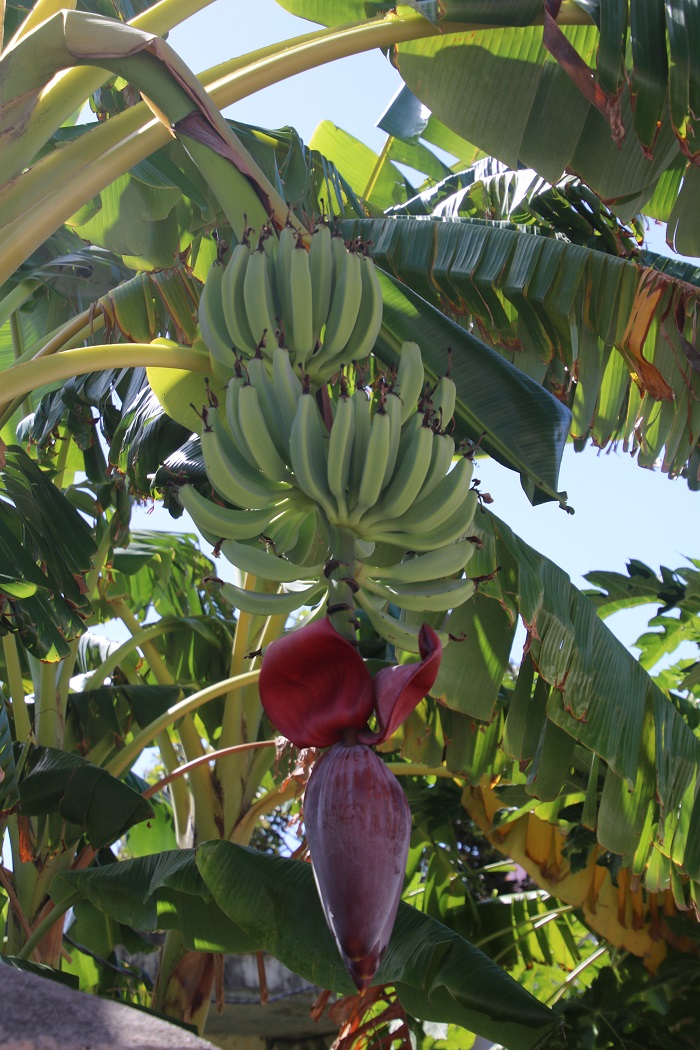 Papayas so big you could never finish even one.
Papayas so big you could never finish even one. 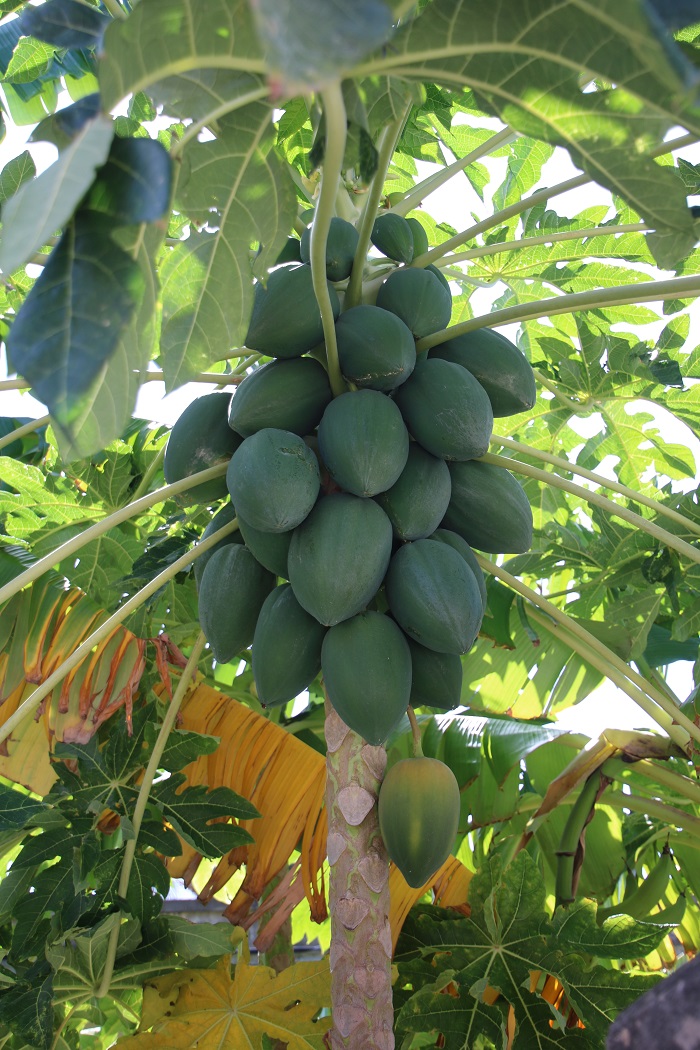 Our first stop after leaving Antigua, before Les Saintes was Deshais, a tiny fishing village on the Northwest coast of Guadeloupe. The harbor can be pretty rolly with a wrap-around swell and the swell was up when we arrived. Fortunately, the swell dropped after a day and made for a pleasant visit.
Our first stop after leaving Antigua, before Les Saintes was Deshais, a tiny fishing village on the Northwest coast of Guadeloupe. The harbor can be pretty rolly with a wrap-around swell and the swell was up when we arrived. Fortunately, the swell dropped after a day and made for a pleasant visit.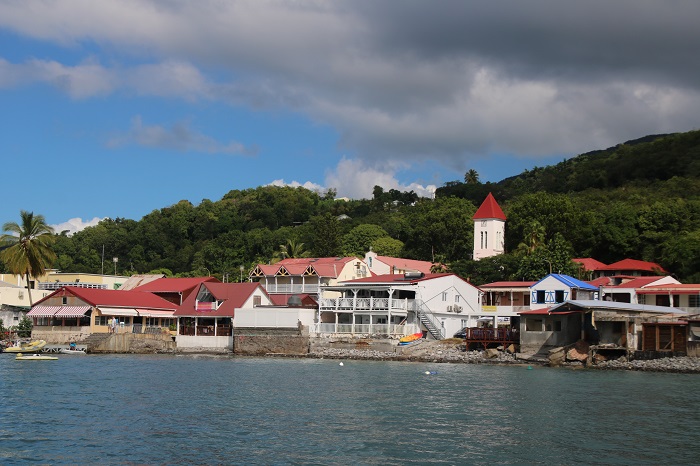 The town dock can be a bit tricky when the surf is on, as it was during our visit so we took our dink down the little canal on the Deshais river. We were told that the week before we arrived the waves were breaking at the mouth of this canal. The swell in the harbor can be so bad that they have to remove the top of the dock to keep it from blowing off with the waves crashing against the shore. Even when it’s calm, the town dock can be a bit of a challenge to land on.
The town dock can be a bit tricky when the surf is on, as it was during our visit so we took our dink down the little canal on the Deshais river. We were told that the week before we arrived the waves were breaking at the mouth of this canal. The swell in the harbor can be so bad that they have to remove the top of the dock to keep it from blowing off with the waves crashing against the shore. Even when it’s calm, the town dock can be a bit of a challenge to land on. 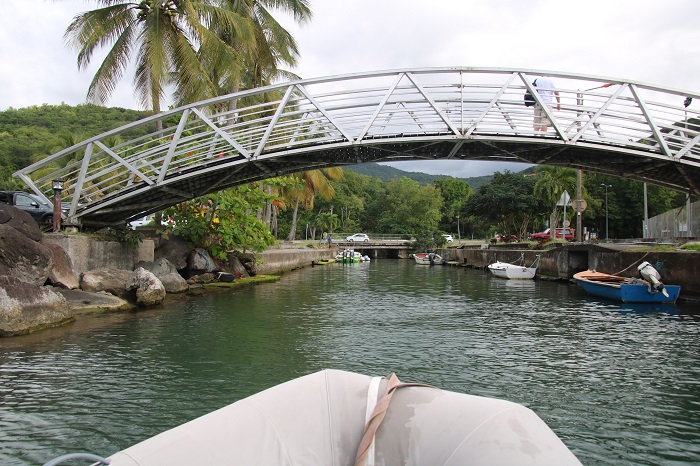 You can walk a short distance up the river and swim in one of the small pools between the cascades on the river, more of a stream, actually. The water is a bit milky and I expect that is because the water leaches out of limestone springs. As it is coming directly down from the mountains I doubt it’s polluted. After this I went in for a swim. It was chilly but what a change of pace. Fresh Water!
You can walk a short distance up the river and swim in one of the small pools between the cascades on the river, more of a stream, actually. The water is a bit milky and I expect that is because the water leaches out of limestone springs. As it is coming directly down from the mountains I doubt it’s polluted. After this I went in for a swim. It was chilly but what a change of pace. Fresh Water! The main street in town is lined with colorful restaurants and shops.
The main street in town is lined with colorful restaurants and shops. 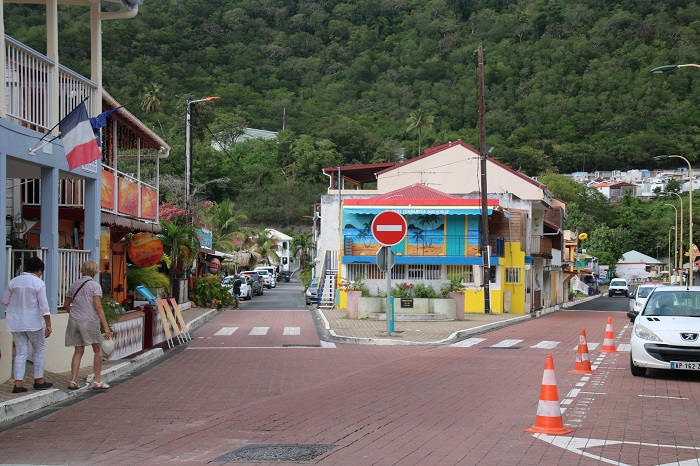 We had a terrific meal, French of course, here with some cruiser friends.
We had a terrific meal, French of course, here with some cruiser friends. 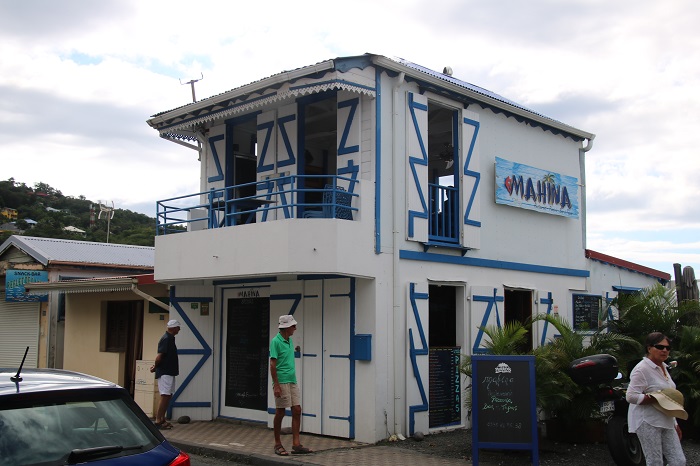 Each restaurant is more charming than the next. This particular one is featured in the TV series, Death in Paradise.
Each restaurant is more charming than the next. This particular one is featured in the TV series, Death in Paradise.  Buildings on the waterfront are beaten up from time to time in storms. I guess this one hasn’t been repaired quite yet.
Buildings on the waterfront are beaten up from time to time in storms. I guess this one hasn’t been repaired quite yet. 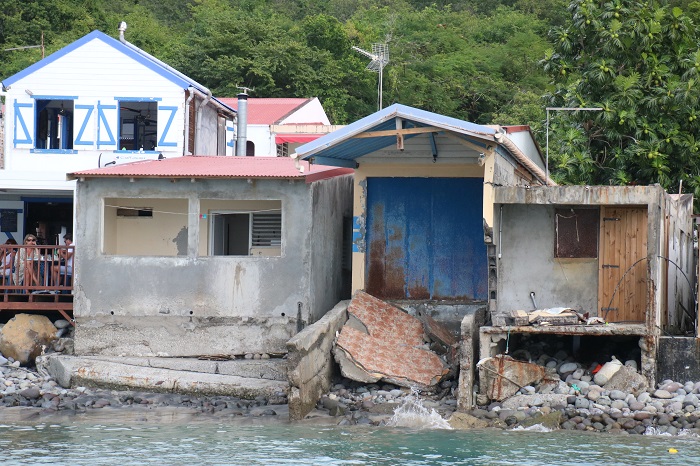 Fishing is a big part of what goes on in Deshais and every evening and into the early morning before dawn we were rocking and rolling as the fisherman headed out and returned with their days catch.
Fishing is a big part of what goes on in Deshais and every evening and into the early morning before dawn we were rocking and rolling as the fisherman headed out and returned with their days catch.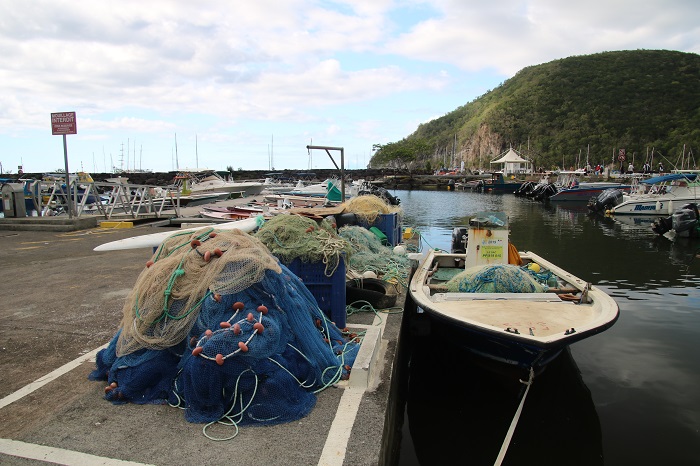 And, of course, where there are fish there are pelicans looking to find a way to prove that their “mouth can hold more than their belly can.” I was just happy that they weren’t killing time waiting for their next meal aboard Pandora.
And, of course, where there are fish there are pelicans looking to find a way to prove that their “mouth can hold more than their belly can.” I was just happy that they weren’t killing time waiting for their next meal aboard Pandora. Brenda and I spent a day with some friends from a boat Billy Ruffin and toured the nearby botanical gardens, one of the best in the Caribbean. The view from the visitors center is first rate.
Brenda and I spent a day with some friends from a boat Billy Ruffin and toured the nearby botanical gardens, one of the best in the Caribbean. The view from the visitors center is first rate. They have a large collection of koi that are always ready for a handout.
They have a large collection of koi that are always ready for a handout. 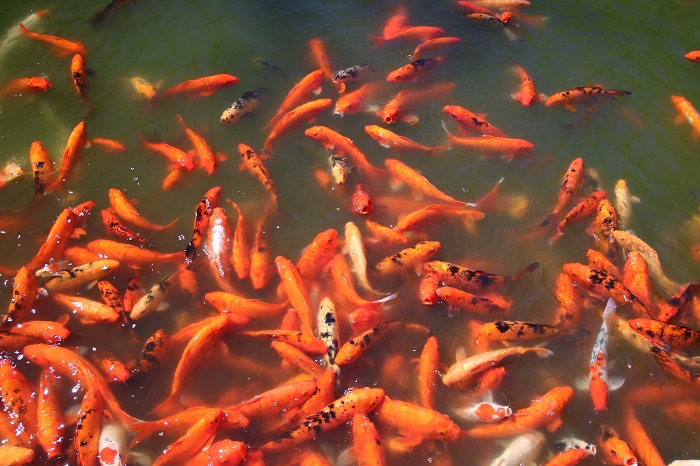 All of these fish, and there are hundreds of them, are up to two feet long.
All of these fish, and there are hundreds of them, are up to two feet long. 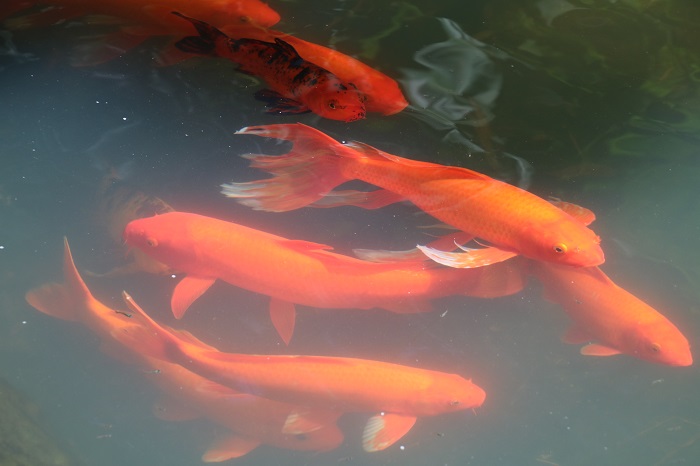 While the gardens are mostly focused on plants, there are a number of birds to enjoy including these beautiful parrots that live in a large open air aviary that you can enter and see up close.
While the gardens are mostly focused on plants, there are a number of birds to enjoy including these beautiful parrots that live in a large open air aviary that you can enter and see up close. 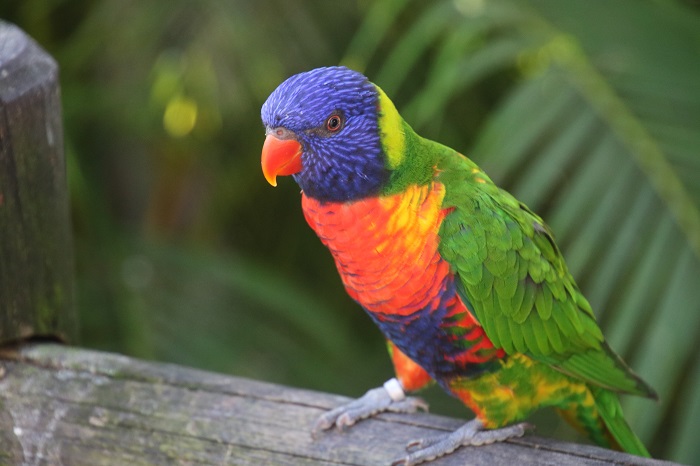 And who doesn’t like flamingos?
And who doesn’t like flamingos?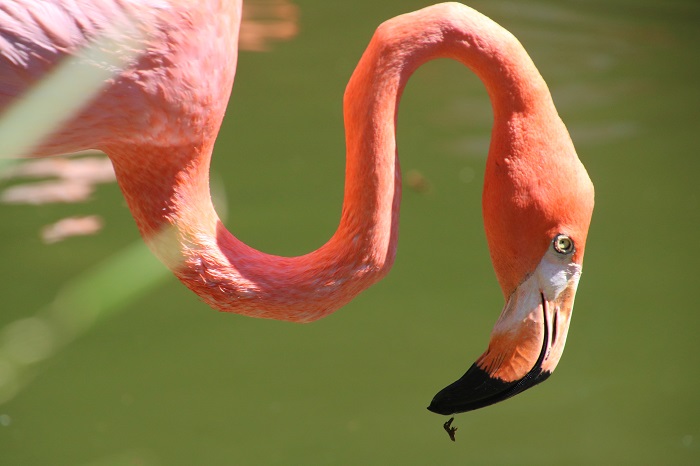 This big macaw, seeming to challenge “what you lookin at?”
This big macaw, seeming to challenge “what you lookin at?” 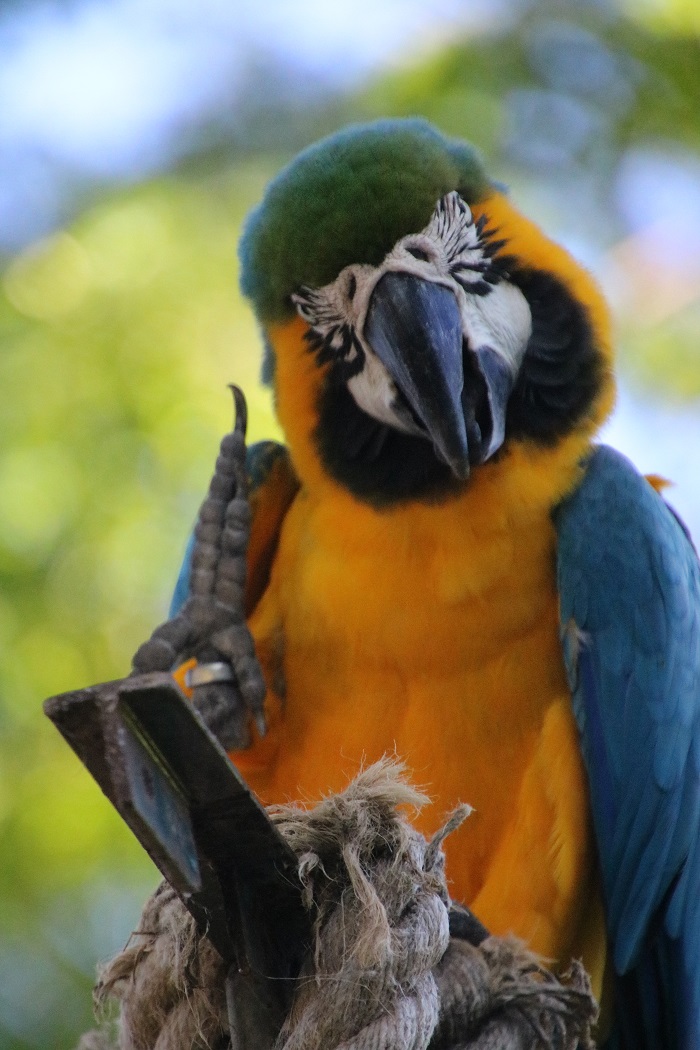 And, of course, lots of plants and flowers, far too many to show here.
And, of course, lots of plants and flowers, far too many to show here. 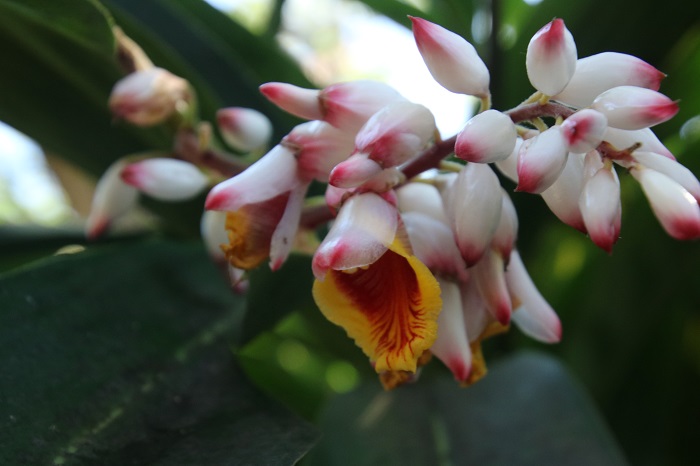 These puffy flowers show up before the leaves on this tree. They are 10′ puffs of pink against a perfect blue sky.
These puffy flowers show up before the leaves on this tree. They are 10′ puffs of pink against a perfect blue sky. 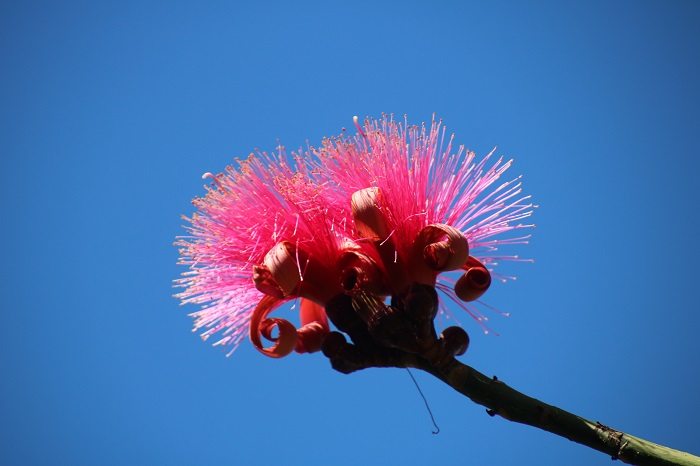 I love the contrast of the red roofs, a signature style here, against the clear blue tropical sky and even bluer ocean.
I love the contrast of the red roofs, a signature style here, against the clear blue tropical sky and even bluer ocean. 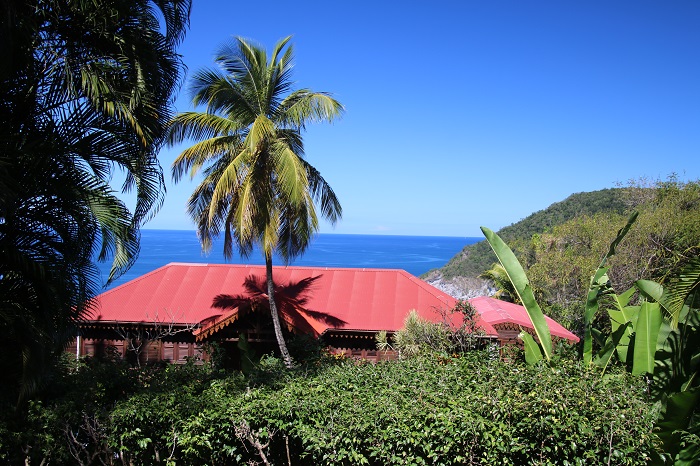 From the edge of the property, a view of the boats in the harbor. That’s Pandora, third from the right.
From the edge of the property, a view of the boats in the harbor. That’s Pandora, third from the right. 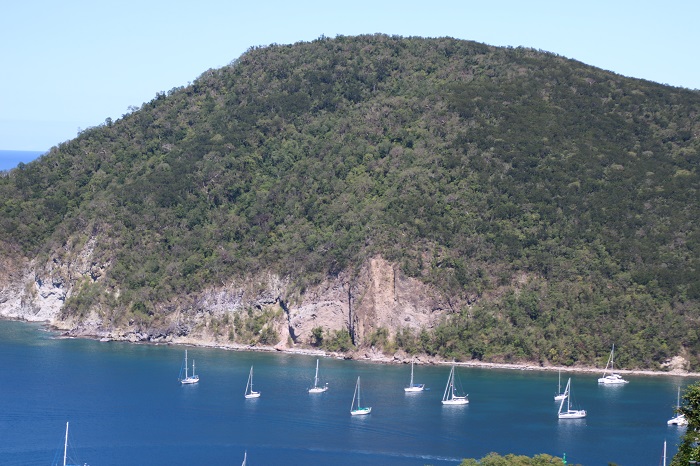 Pandora up close.
Pandora up close.  So here we are in Les Saintes, one of our favorite spots to spend time. We’ve taken a mooring for a week but it looks like we may have to make a run to Martinique soon as the winds are likely to pick up quite a bit and we need to be there or in St Lucia in a few weeks when we hope that the new compressor for our fridge will arrive and none too soon as it’s sounding worse each day. I sure hope that it doesn’t give up the ghost before the new one arrives.
So here we are in Les Saintes, one of our favorite spots to spend time. We’ve taken a mooring for a week but it looks like we may have to make a run to Martinique soon as the winds are likely to pick up quite a bit and we need to be there or in St Lucia in a few weeks when we hope that the new compressor for our fridge will arrive and none too soon as it’s sounding worse each day. I sure hope that it doesn’t give up the ghost before the new one arrives.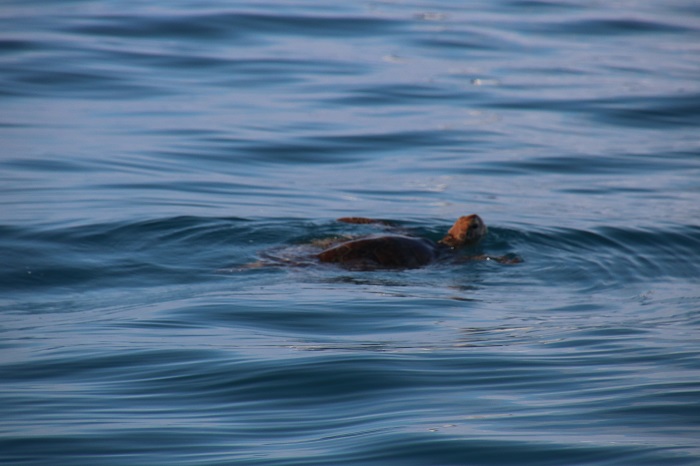 There is a bit of a swell coming into the harbor so we had a somewhat rolly night but the sun is out and it’s a beautiful day.
There is a bit of a swell coming into the harbor so we had a somewhat rolly night but the sun is out and it’s a beautiful day. Yesterday Brenda and I rented a car with some new cruising friends and toured the island of Guadeloupe. We had lunch in an excellent French restaurant along the way and visited a rum distillery but the highlight of the day was a hike into the rainforest to view
Yesterday Brenda and I rented a car with some new cruising friends and toured the island of Guadeloupe. We had lunch in an excellent French restaurant along the way and visited a rum distillery but the highlight of the day was a hike into the rainforest to view  Near the parking area was an overlook to give us an idea of what we were going to see, the spectacular double falls in the distance.
Near the parking area was an overlook to give us an idea of what we were going to see, the spectacular double falls in the distance. 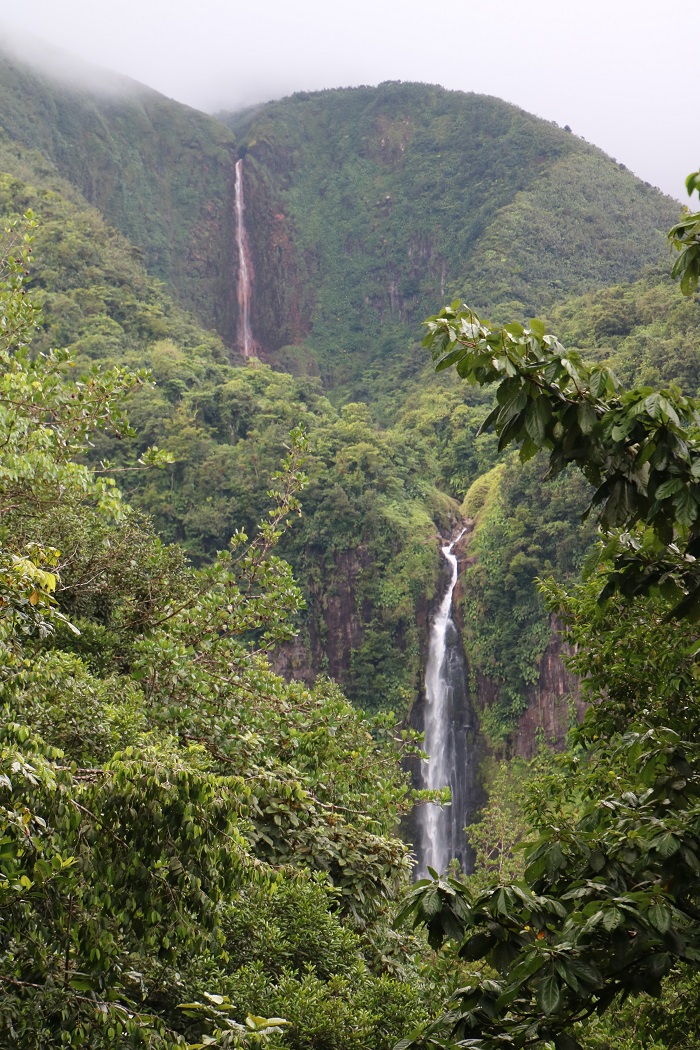 The path we took was labeled as easy and was very well maintained with pavers and wooden walkways the entire way. However, because of the constant wet from rain and mist, it was still slippery.
The path we took was labeled as easy and was very well maintained with pavers and wooden walkways the entire way. However, because of the constant wet from rain and mist, it was still slippery.  Everywhere you turned, something was growing, from tiny moss and ferns to trees hundreds of feet tall.
Everywhere you turned, something was growing, from tiny moss and ferns to trees hundreds of feet tall. 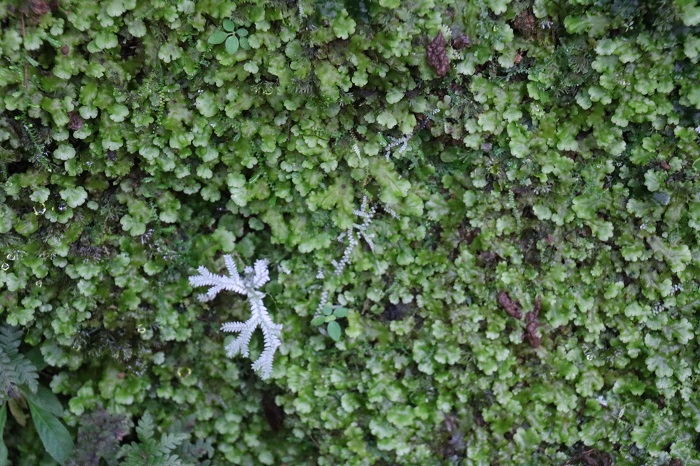 It seemed like every branch had something growing on it.
It seemed like every branch had something growing on it. 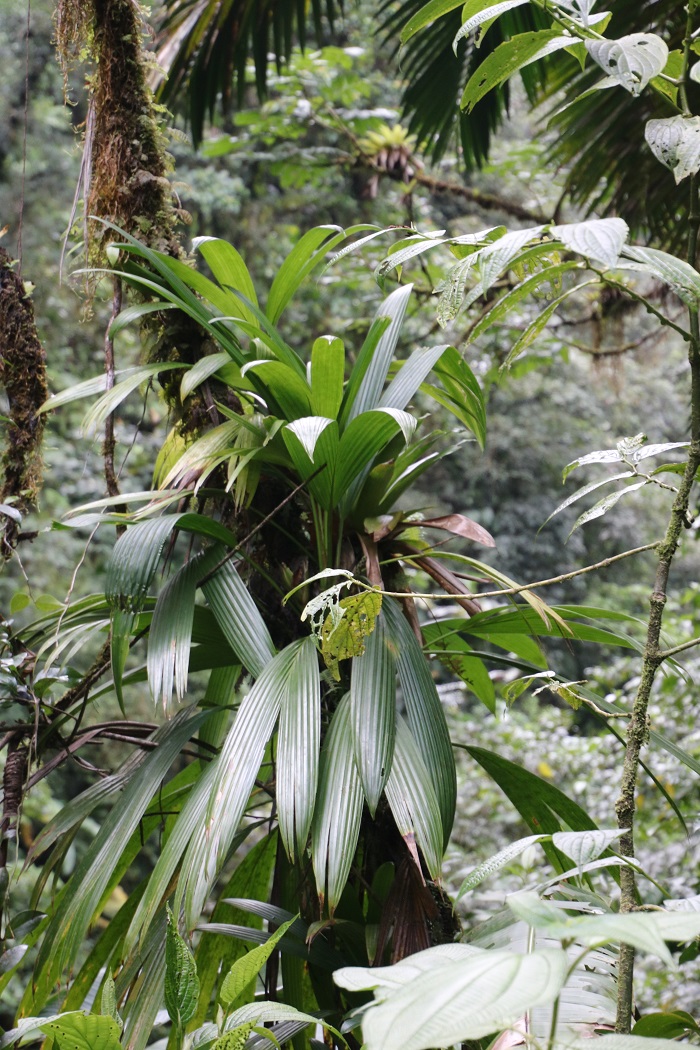 Some of the ferns were 40′ tall with fronds that stretched 8′.
Some of the ferns were 40′ tall with fronds that stretched 8′.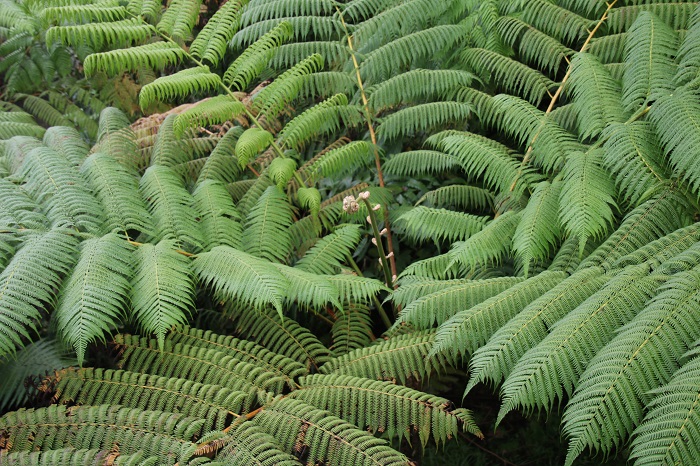 The path followed the stream up to the falls.
The path followed the stream up to the falls. 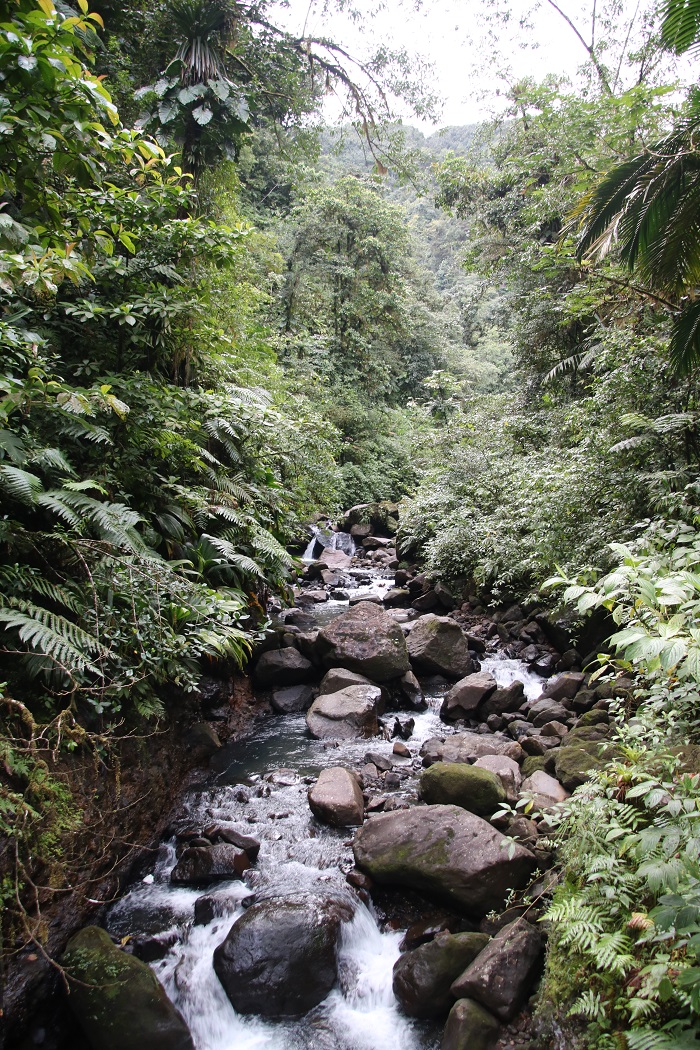 The top of the mountain, some 4,000′ tall, was shrouded in clouds and mist.
The top of the mountain, some 4,000′ tall, was shrouded in clouds and mist. 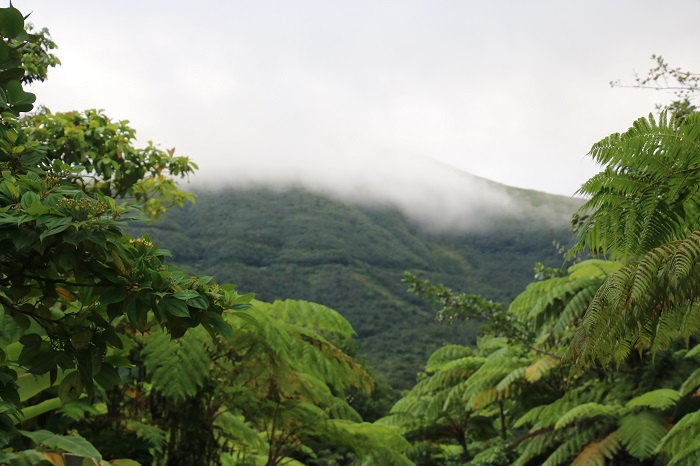 After walking up and down, down and up, we arrived at the overlook with the water crashing down from the lower falls in the distance. What a view.
After walking up and down, down and up, we arrived at the overlook with the water crashing down from the lower falls in the distance. What a view. There was a little bird looking at us, perhaps hoping for a handout.
There was a little bird looking at us, perhaps hoping for a handout.  I am always on the lookout for orchids and didn’t see any. That’s not unusual as they generally grow high up in the forest canopy, hundreds of feet up where the light is bright but hard to see from the forest floor.
I am always on the lookout for orchids and didn’t see any. That’s not unusual as they generally grow high up in the forest canopy, hundreds of feet up where the light is bright but hard to see from the forest floor. The island mountains are so steep and there is only a single road that runs around the perimeter of the island, with what seems like hundreds of switchbacks and winding curves that follow the coastline. Driving these roads can get tiring after a while as it’s more like a slalom course where going more than 30 kph is tough.
The island mountains are so steep and there is only a single road that runs around the perimeter of the island, with what seems like hundreds of switchbacks and winding curves that follow the coastline. Driving these roads can get tiring after a while as it’s more like a slalom course where going more than 30 kph is tough. A charming building.
A charming building.  Including a mix of new and old.
Including a mix of new and old. 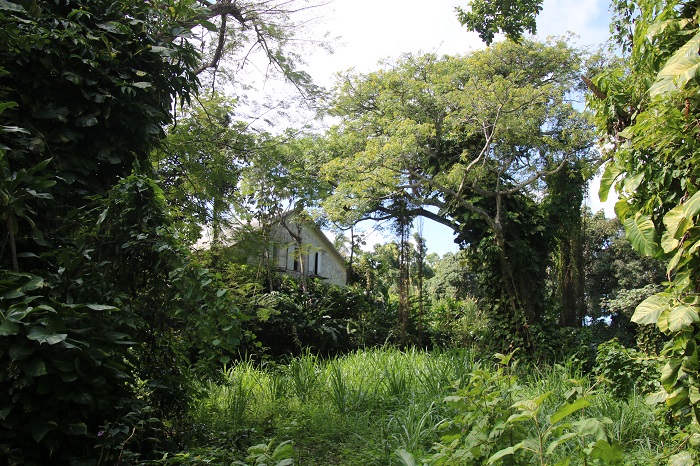 I swear that I only had a tiny taste.
I swear that I only had a tiny taste.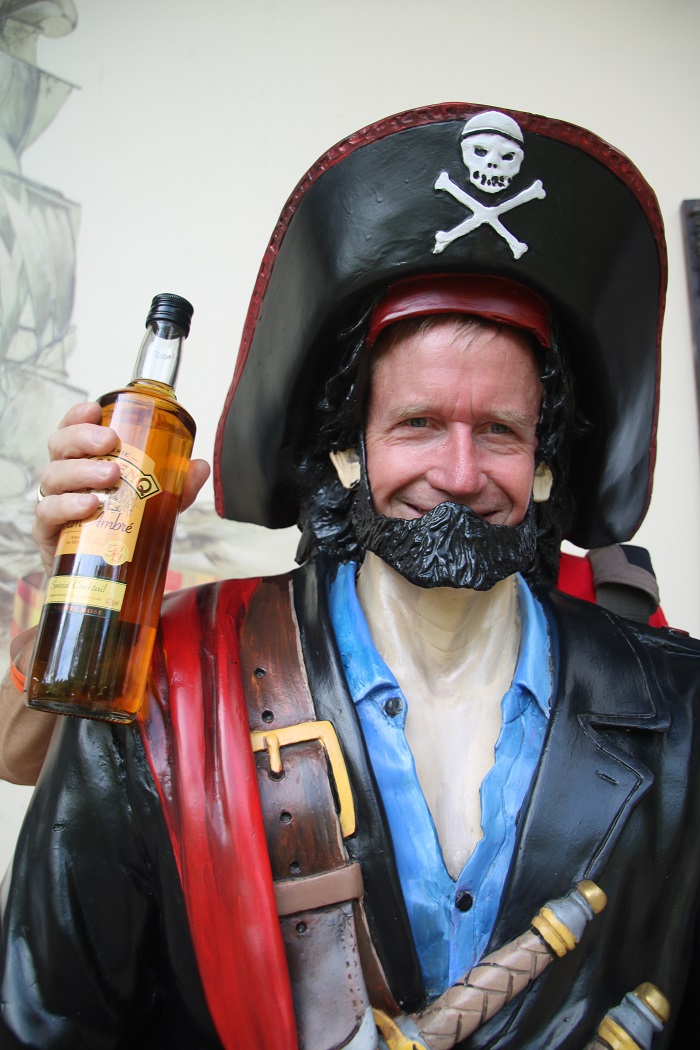 As a museum, they had a very eclectic mix of stuff in their collection. A number of ship models including such unrelated designs as a Mississippi steamer, Christoper Columbus’s ships and, well, an odd mix.
As a museum, they had a very eclectic mix of stuff in their collection. A number of ship models including such unrelated designs as a Mississippi steamer, Christoper Columbus’s ships and, well, an odd mix.  Along with some life size dinosaur models, both outside and in, they had a huge collection of bugs in frames.
Along with some life size dinosaur models, both outside and in, they had a huge collection of bugs in frames. 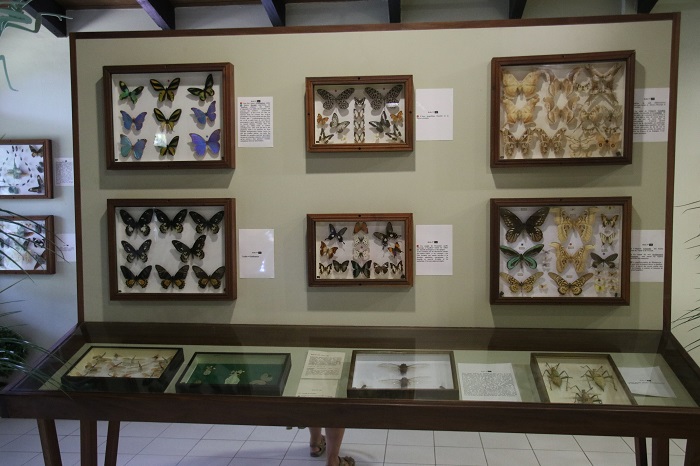 Tiny ones all lined up behind glass.
Tiny ones all lined up behind glass. 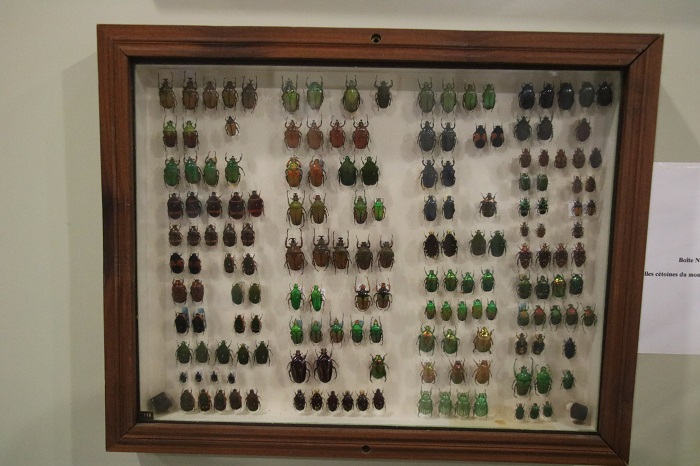 Butterflies of all kinds.
Butterflies of all kinds. 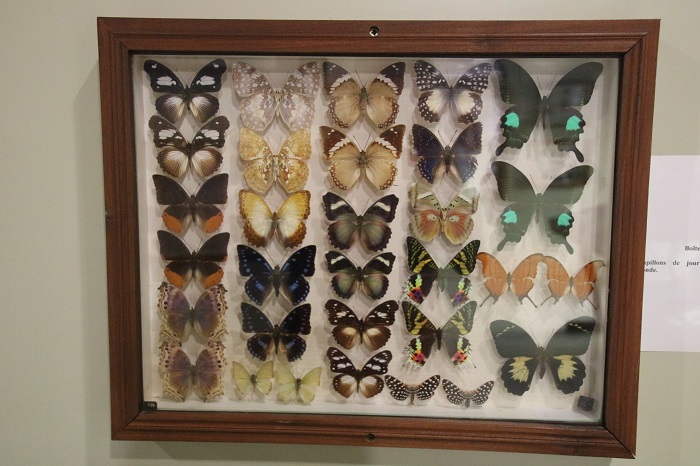 And lots that I’d hate running into at night.
And lots that I’d hate running into at night. 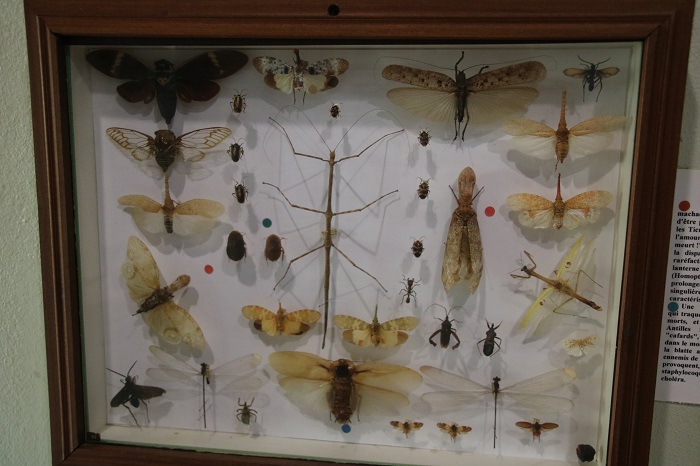 Some bigger than you’d want to imagine, about 12″ long. To make matters worse, they are the sort that flies, I expect.
Some bigger than you’d want to imagine, about 12″ long. To make matters worse, they are the sort that flies, I expect.  Of course, everyone’s favorites, horned beetles.
Of course, everyone’s favorites, horned beetles. 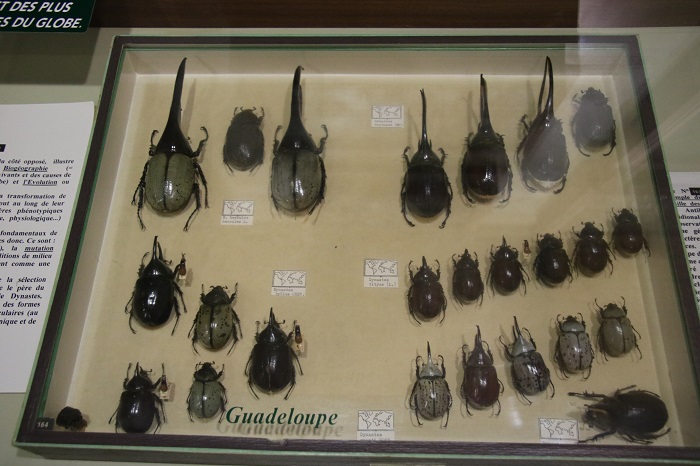 Ask yourself, what museum is complete without a collection of sand, all carefully labeled?
Ask yourself, what museum is complete without a collection of sand, all carefully labeled?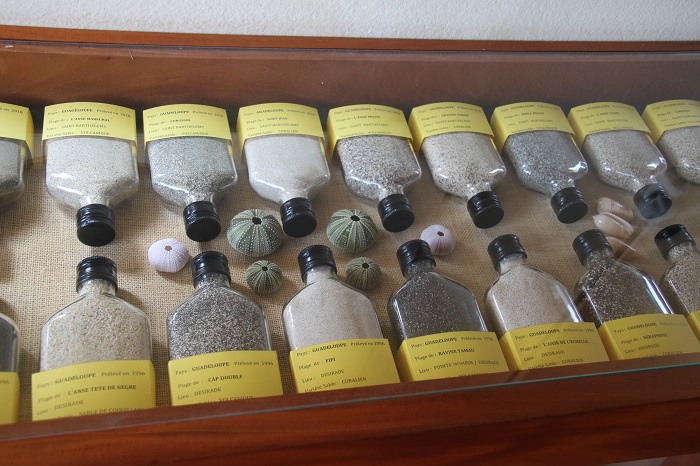 After the tour of the collection, all I could think of was someone saying “what in the world are we going to do with Dad’s collections? Have a tag sale? No, wait, let’s open a museum! Any better ideas?”
After the tour of the collection, all I could think of was someone saying “what in the world are we going to do with Dad’s collections? Have a tag sale? No, wait, let’s open a museum! Any better ideas?”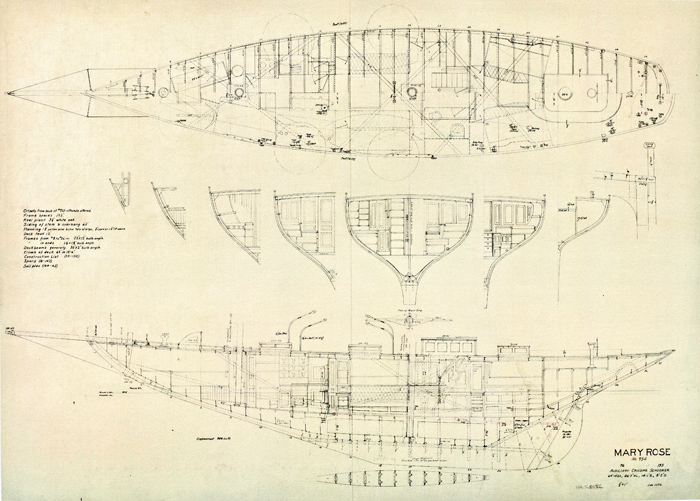 And even more beautiful under a full press of sails.
And even more beautiful under a full press of sails.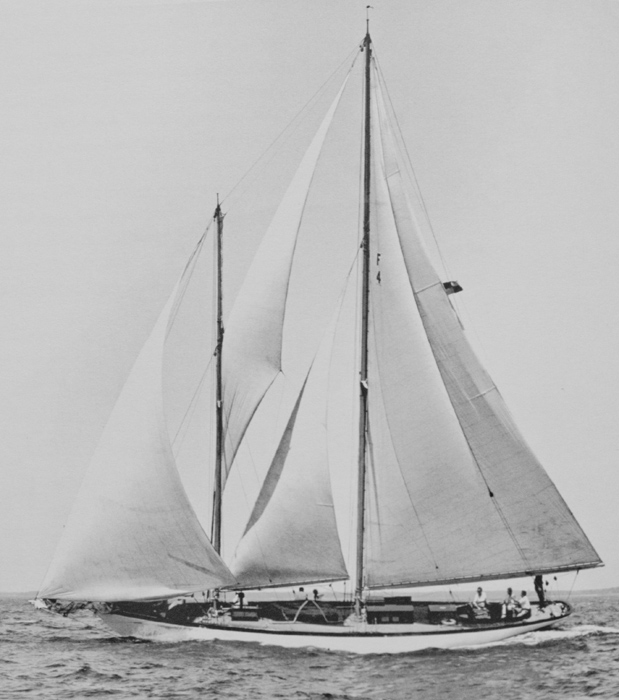 Mary Rose has had a number of owners over the years including Hugh Hefner, who used her as a set for a 1959 issue of Playboy. She was called Gallant at that time.
Mary Rose has had a number of owners over the years including Hugh Hefner, who used her as a set for a 1959 issue of Playboy. She was called Gallant at that time. 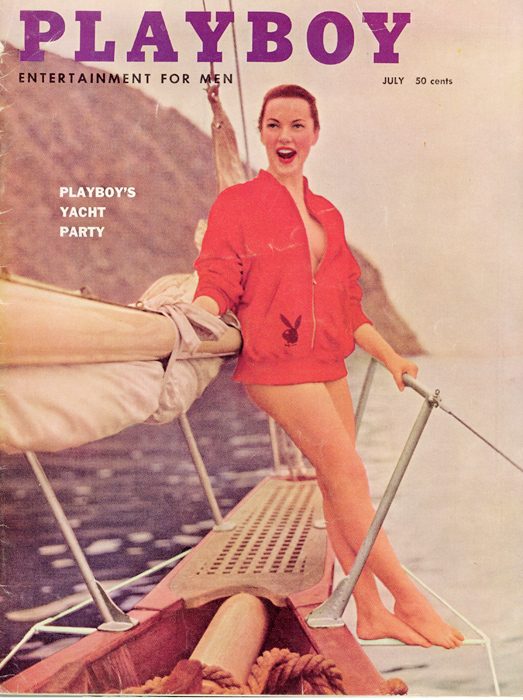 Mary Rose is very likely in way better shape these days than the “bunnies” that spent time aboard her nearly 60 years ago.
Mary Rose is very likely in way better shape these days than the “bunnies” that spent time aboard her nearly 60 years ago. Today she lives a somewhat less exciting life full time in English Harbor, Antigua where I spent time aboard with her owner Gerald. I had been admiring Mary Rose for a number of years as she swung on her mooring off of the Admiral’s Inn and had wondered how I might get aboard for a look.
Today she lives a somewhat less exciting life full time in English Harbor, Antigua where I spent time aboard with her owner Gerald. I had been admiring Mary Rose for a number of years as she swung on her mooring off of the Admiral’s Inn and had wondered how I might get aboard for a look. 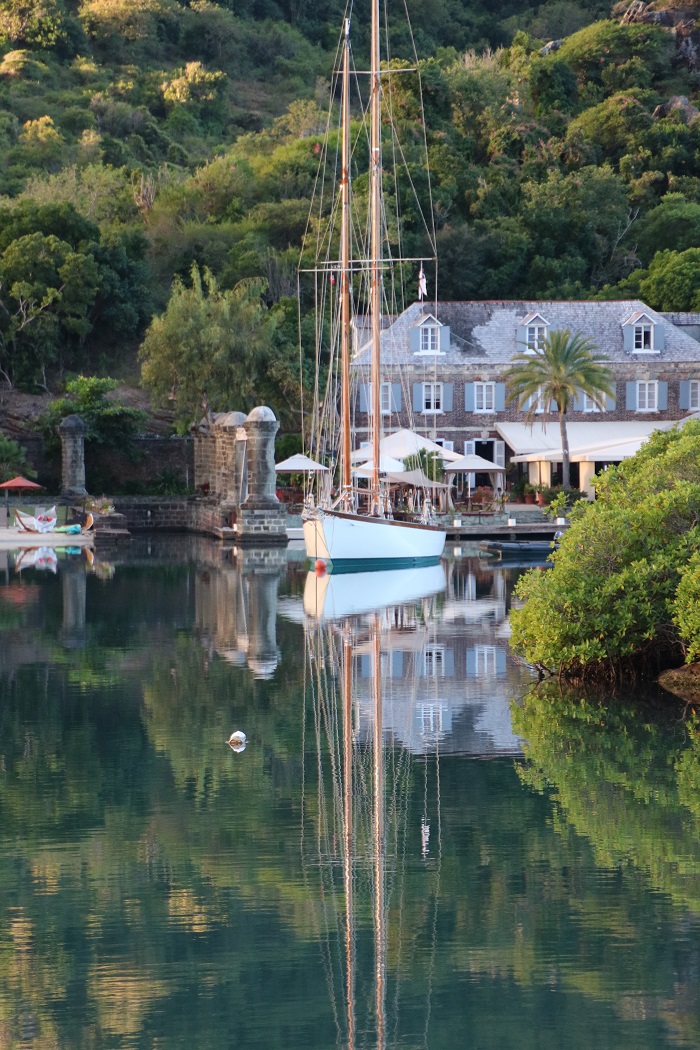
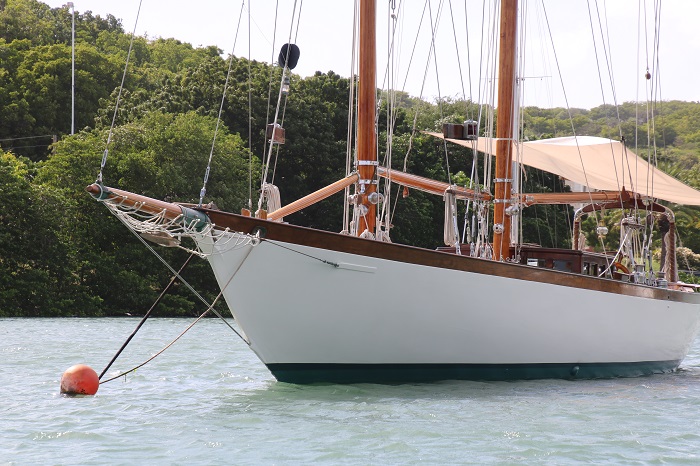 Gerald keeps here in Antigua full time and stores her, during the hurricane season, in what might be best described as concrete bunker designed to withstand hurricane force winds. It is in her cocoon that a long list of off-season chores are done to keep her looking new as she prepares to enter her second century.
Gerald keeps here in Antigua full time and stores her, during the hurricane season, in what might be best described as concrete bunker designed to withstand hurricane force winds. It is in her cocoon that a long list of off-season chores are done to keep her looking new as she prepares to enter her second century.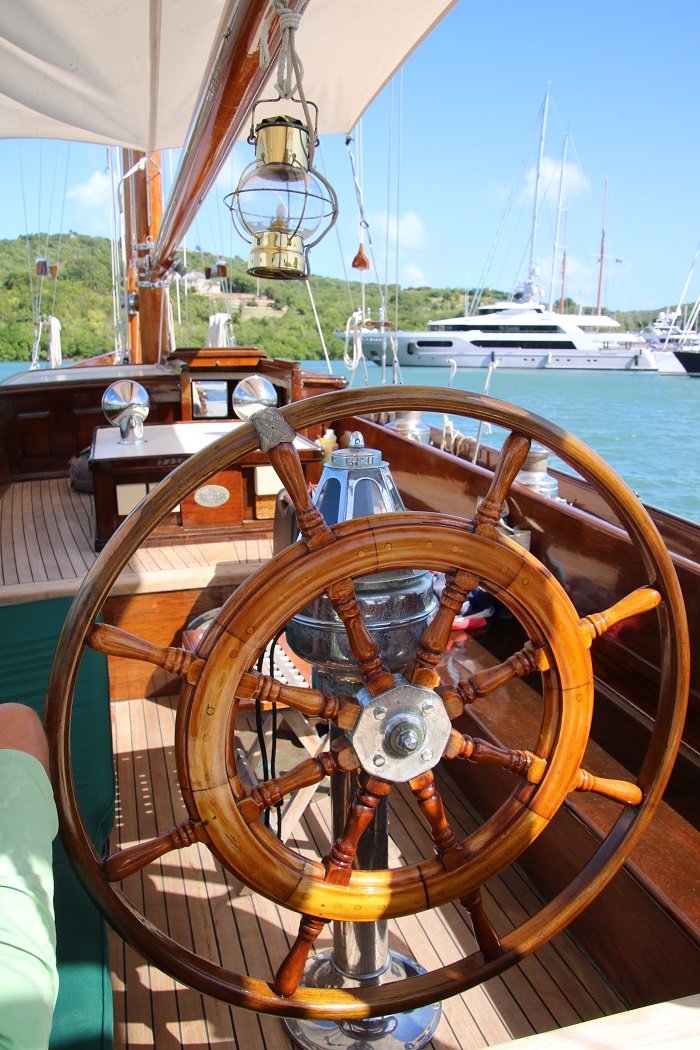 And the original builders plaque commemorating her as design #954.
And the original builders plaque commemorating her as design #954.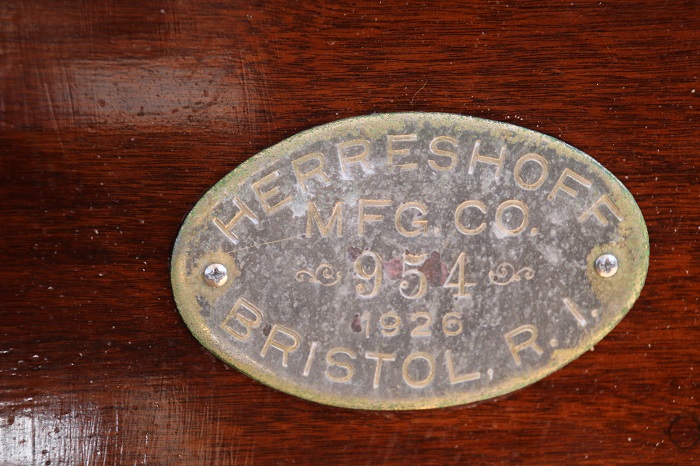 How about these beveled port lights, original of course.
How about these beveled port lights, original of course. 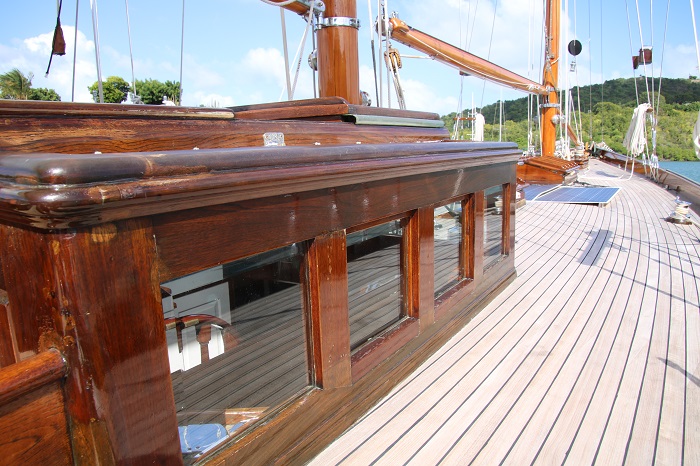 And, as you would expect, beautiful deck hatches, worthy of any proper yacht.
And, as you would expect, beautiful deck hatches, worthy of any proper yacht.  Her hardware, and it’s all original, has been refurbished over the years.
Her hardware, and it’s all original, has been refurbished over the years. 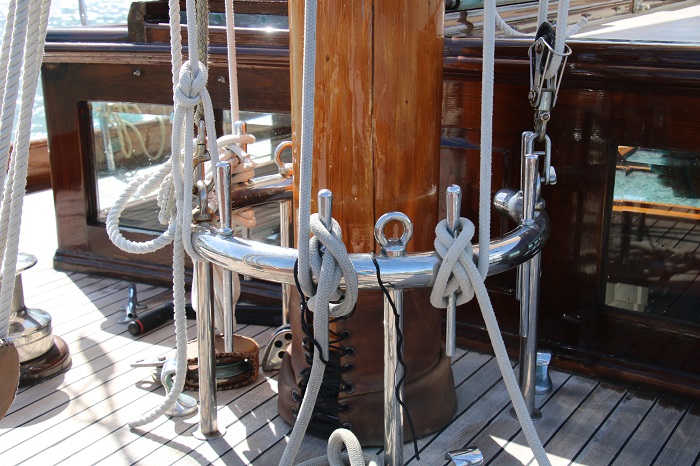 The goose neck, with it’s interesting vertical bar is worth noting. When the sail is hoisted, the boom raises up to the top of the slide.
The goose neck, with it’s interesting vertical bar is worth noting. When the sail is hoisted, the boom raises up to the top of the slide. 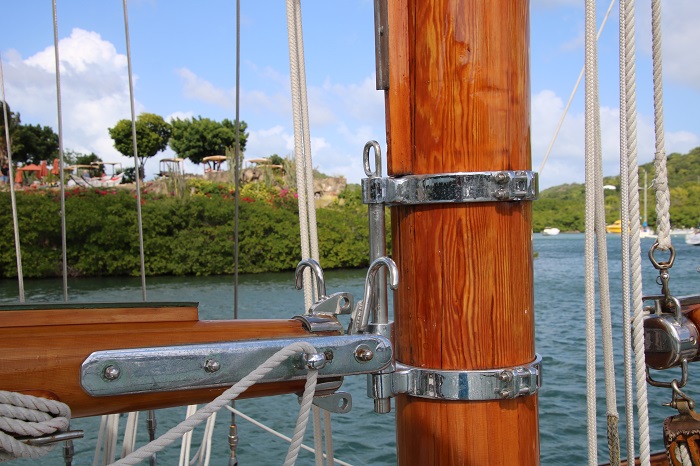 Gerald was proud to show me the recent scarf joints on the boom where there had been some decay. It was beautifully done with perfect hairline glue lines.
Gerald was proud to show me the recent scarf joints on the boom where there had been some decay. It was beautifully done with perfect hairline glue lines.  Everywhere lovely leather covers for shell blocks and covering whatever hardware might mar the decks, varnish or paint.
Everywhere lovely leather covers for shell blocks and covering whatever hardware might mar the decks, varnish or paint.  I was taken by what must have been a very innovative piece of hardware on her mast track to hoist the storm sail.
I was taken by what must have been a very innovative piece of hardware on her mast track to hoist the storm sail. 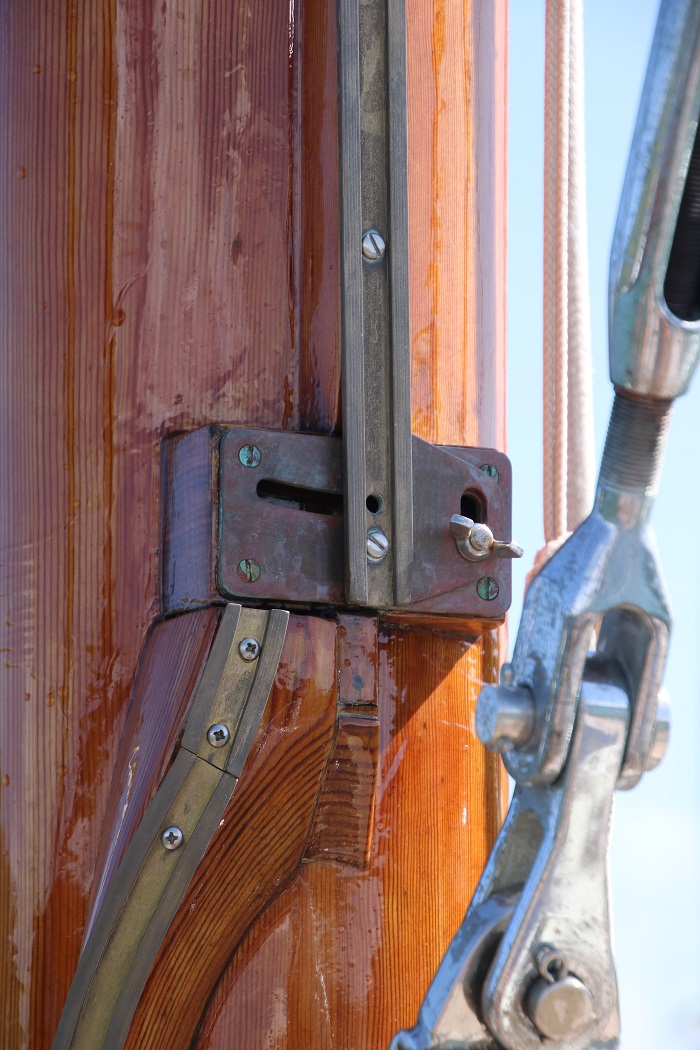 One departure from the original designed to make here easier to sail short handed, was the addition of a boom-kin. Of course, Gerald consulted with experts at the Herreshoff museum in Bristol RI where he sits on the board of directors. It’s a lovely addition and surely Capt Nat, always the innovator himself, would have approved. This change made it possible to remove one of the two sets of running backstays, an important simplification.
One departure from the original designed to make here easier to sail short handed, was the addition of a boom-kin. Of course, Gerald consulted with experts at the Herreshoff museum in Bristol RI where he sits on the board of directors. It’s a lovely addition and surely Capt Nat, always the innovator himself, would have approved. This change made it possible to remove one of the two sets of running backstays, an important simplification. 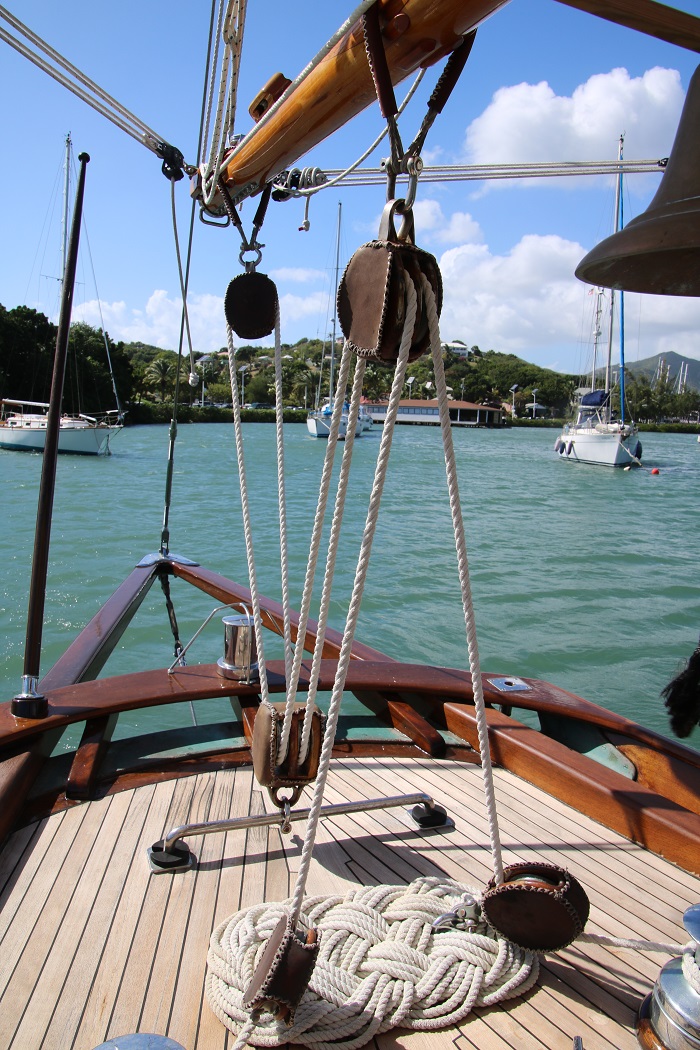 And, on the pointy end.
And, on the pointy end.  As you head down below. What a banister and the classic “Herreshoff interior” white panels with varnished wood trim.
As you head down below. What a banister and the classic “Herreshoff interior” white panels with varnished wood trim.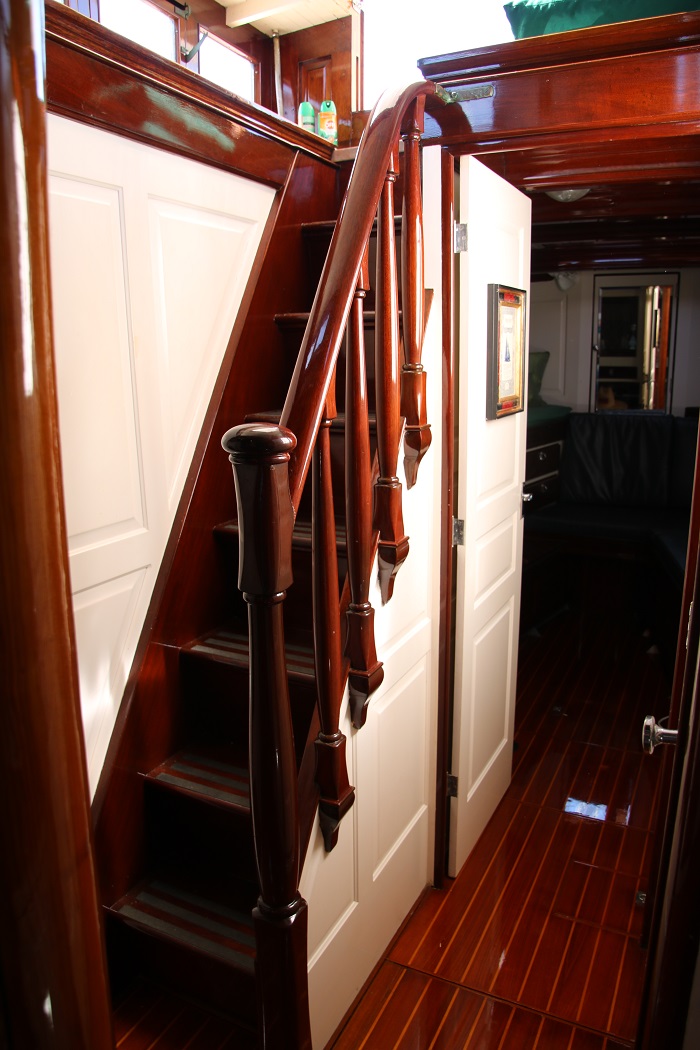 Wonderful glazing on the interior cabinets in the main salon.
Wonderful glazing on the interior cabinets in the main salon.  And a commemorative print when she was launched way back when. However, no sign of that 1959 cover shot.
And a commemorative print when she was launched way back when. However, no sign of that 1959 cover shot. 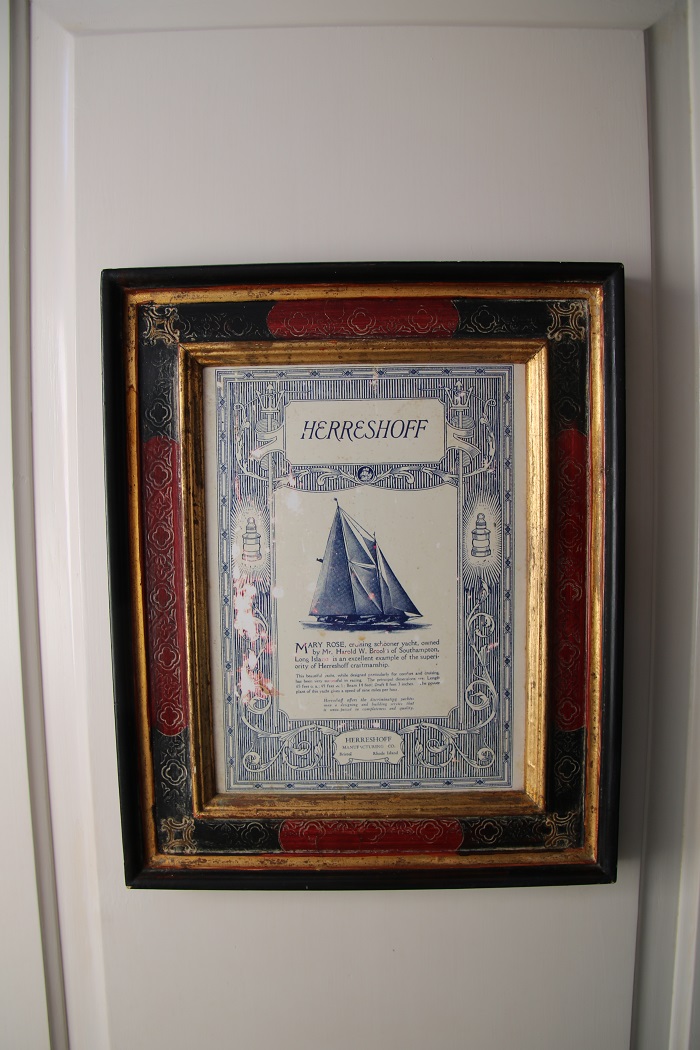 A very nice, functional galley. Of course, with the modern conveniences of generator and refrigeration to keep things civilized when cruising.
A very nice, functional galley. Of course, with the modern conveniences of generator and refrigeration to keep things civilized when cruising.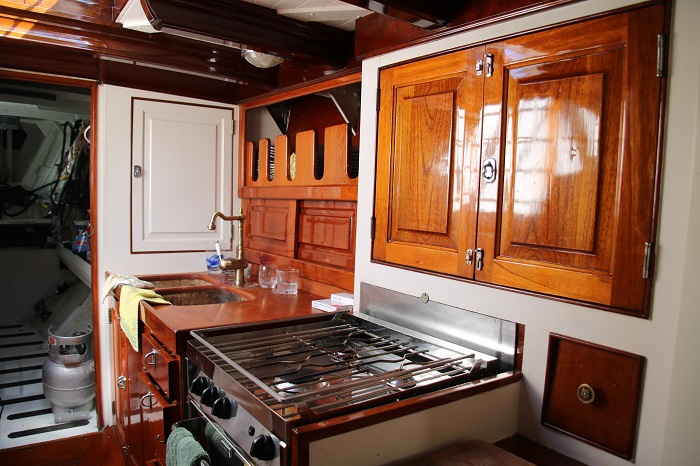 It’s clear from the stuff stored in the forepeak that she is a yacht that is used and not some sort of static museum piece.
It’s clear from the stuff stored in the forepeak that she is a yacht that is used and not some sort of static museum piece. 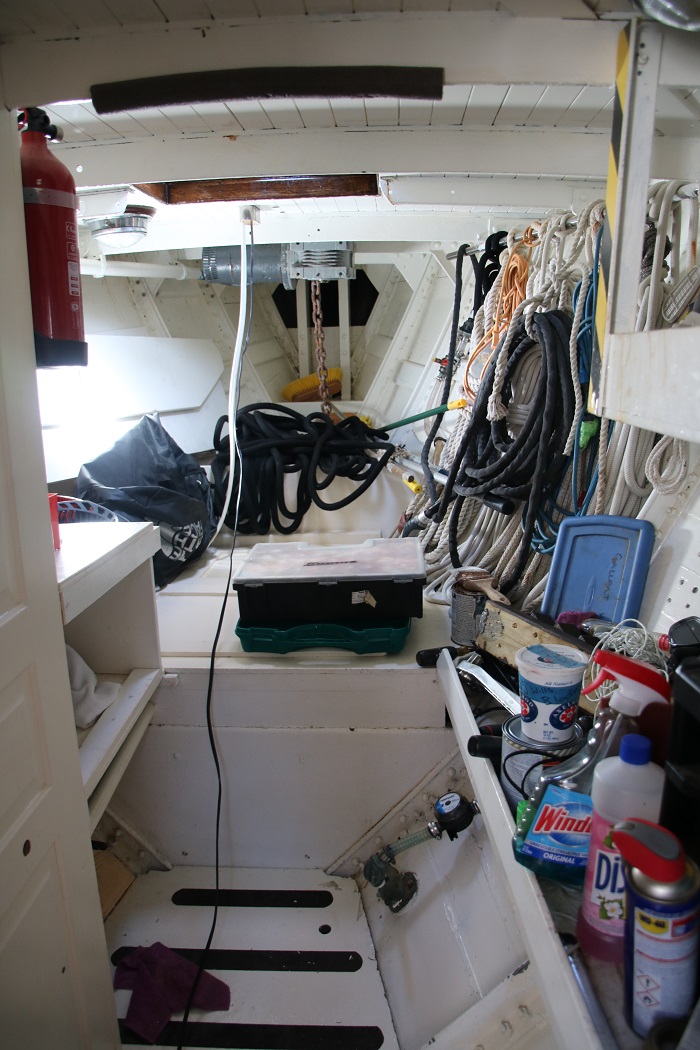 Beautiful restored hardware in the two heads complete with modern heads.
Beautiful restored hardware in the two heads complete with modern heads. 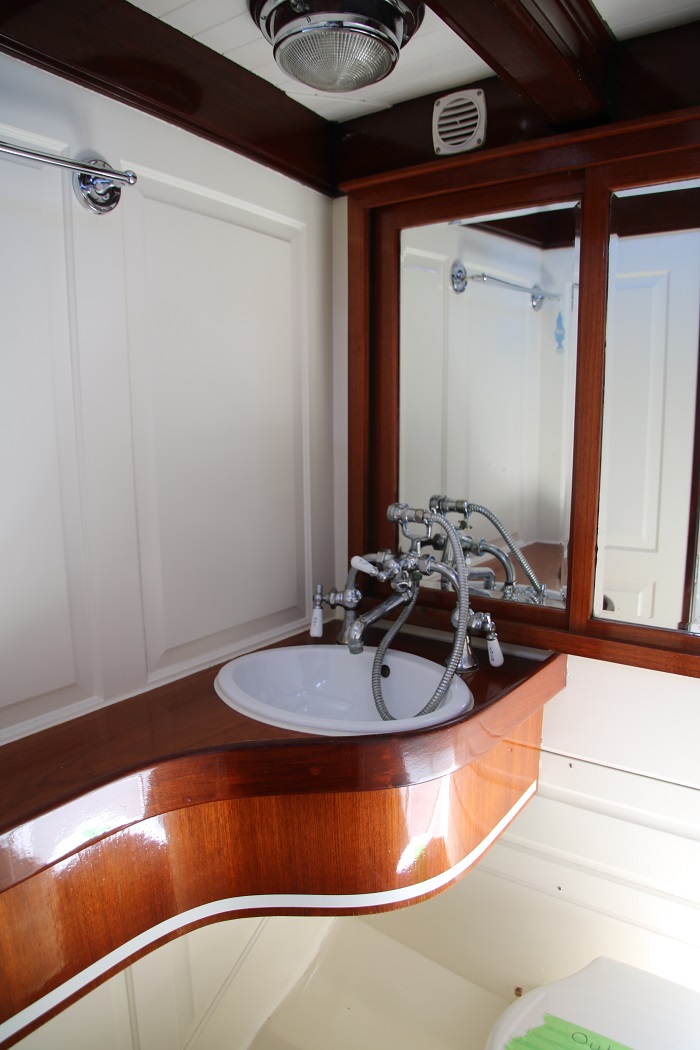 A very nice master cabin although I expect it is a bit stuffy in the tropical climate.
A very nice master cabin although I expect it is a bit stuffy in the tropical climate. 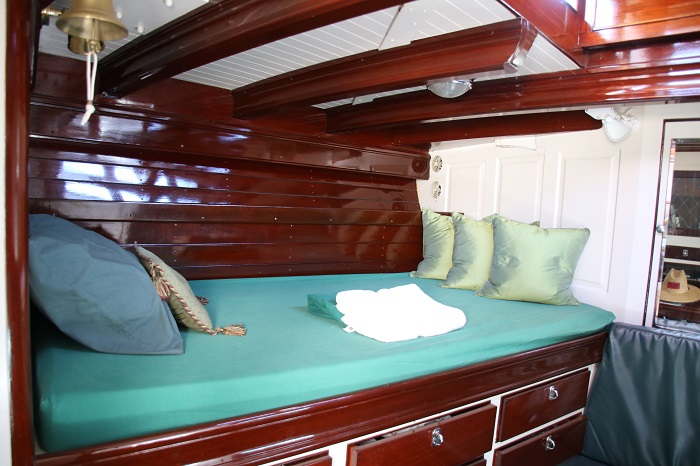 All and all, Mary Rose is a proper yacht with a caring owner and it is clear that he is committed to bringing her into her second century in grand style.
All and all, Mary Rose is a proper yacht with a caring owner and it is clear that he is committed to bringing her into her second century in grand style. The village is impossibly charming with a little French bakery and loads of, you guessed it, French restaurants to choose from. As we got here fairly late yesterday, we ate aboard and enjoyed a bottle of rose, some French cheese and cured meats that I purchased in a charming little shop. Yum! No, make that Triple Yum.
The village is impossibly charming with a little French bakery and loads of, you guessed it, French restaurants to choose from. As we got here fairly late yesterday, we ate aboard and enjoyed a bottle of rose, some French cheese and cured meats that I purchased in a charming little shop. Yum! No, make that Triple Yum.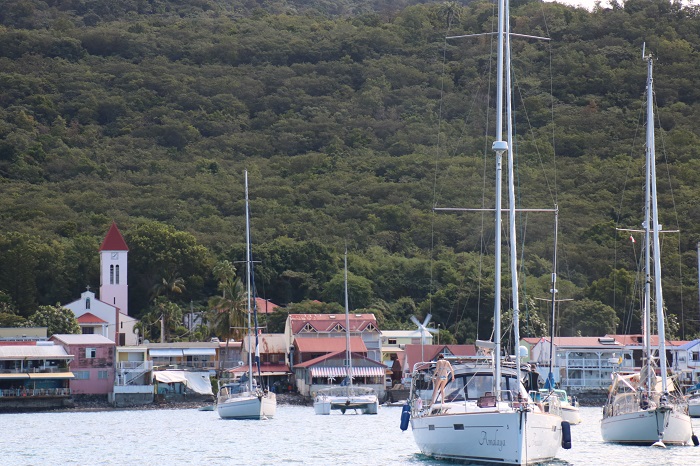 The harbor can be crowded and arriving late in the day we had to anchor fairly far out in 40′ of water. It was a bit rolly but this morning we were able to move in closer and it’s much more settled. At 25′ deep you can clearly see the bottom. Schools of
The harbor can be crowded and arriving late in the day we had to anchor fairly far out in 40′ of water. It was a bit rolly but this morning we were able to move in closer and it’s much more settled. At 25′ deep you can clearly see the bottom. Schools of  There isn’t much wind right now as the trades are low which is a good time to visit. Interestingly, while the trades are always from the east, this harbor has an onshore light westerly wind, a sort of Station Wagon effect, where the wind blows over the mountains and curls around 180 degrees in the lee of the island.
There isn’t much wind right now as the trades are low which is a good time to visit. Interestingly, while the trades are always from the east, this harbor has an onshore light westerly wind, a sort of Station Wagon effect, where the wind blows over the mountains and curls around 180 degrees in the lee of the island.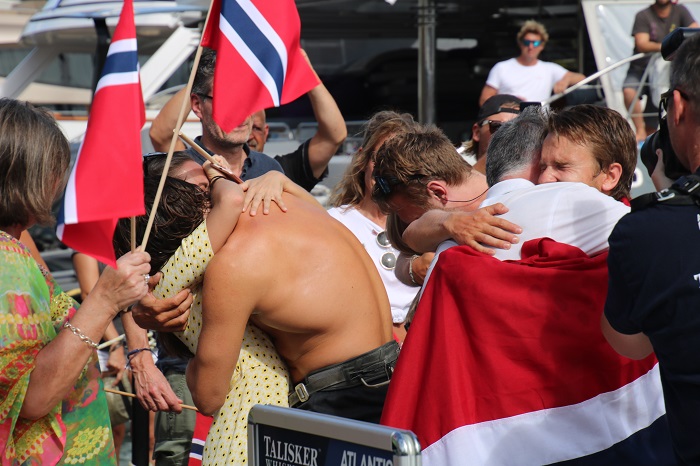 They would be waving American flags, I’d expect. “Here they come! I see them coming into the harbor. Yes, It’s Pandora, I see them, both Bob and Brenda are aboard! YES!!!”
They would be waving American flags, I’d expect. “Here they come! I see them coming into the harbor. Yes, It’s Pandora, I see them, both Bob and Brenda are aboard! YES!!!”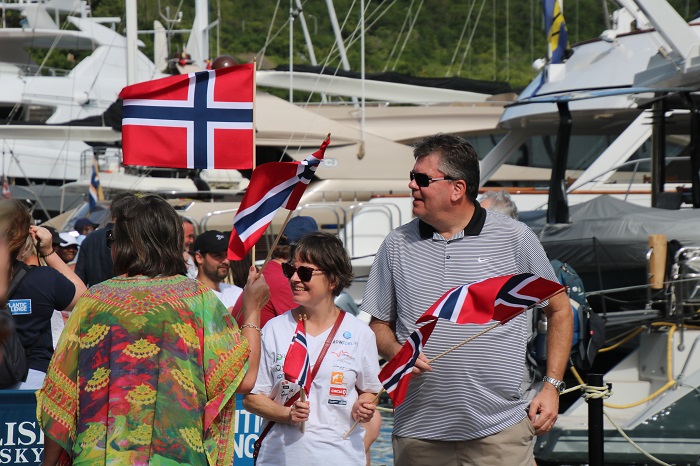 “No wait, it’s only a little rowboat.”
“No wait, it’s only a little rowboat.” Never mind.
Never mind.  The guys on this boat, and there were four aboard, really looked excited to be here.
The guys on this boat, and there were four aboard, really looked excited to be here. 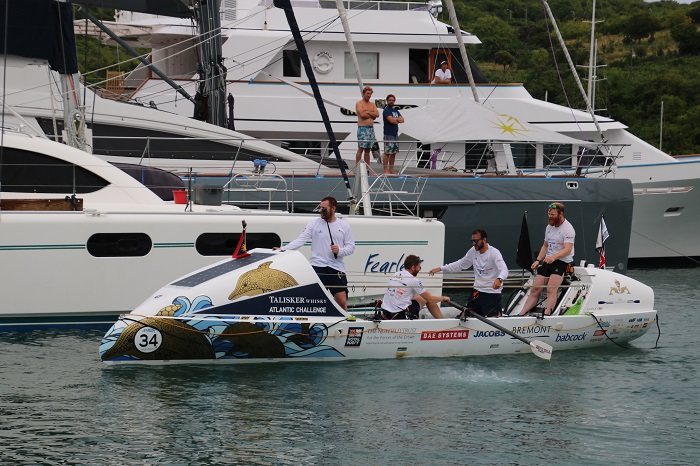 A few days ago, a three man team arrived, brothers. It was quite moving to see them greeted by family and friends.
A few days ago, a three man team arrived, brothers. It was quite moving to see them greeted by family and friends.  And there were speeches all around. They were justifiably proud of what they had accomplished. The MC asked them what the most memorable moment was on the trip and they talked about how a butterfly flew by their boat, following a gale, more than 1,500 miles from anything.
And there were speeches all around. They were justifiably proud of what they had accomplished. The MC asked them what the most memorable moment was on the trip and they talked about how a butterfly flew by their boat, following a gale, more than 1,500 miles from anything.  We have had birds land on board Pandora many times, often more than 500 miles from shore,. Amazing stamina for a tiny insect, flying so far.
We have had birds land on board Pandora many times, often more than 500 miles from shore,. Amazing stamina for a tiny insect, flying so far.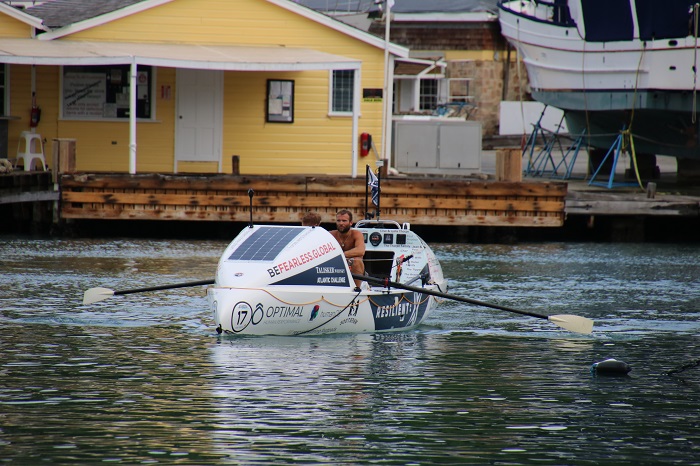 I can only imagine how emotional it must have been for them to arrive after so long at sea and under such tough conditions.
I can only imagine how emotional it must have been for them to arrive after so long at sea and under such tough conditions.  These guys were clearly happy with their accomplishment. I wonder if they were this “buff” at the beginning of their trip. Probably, but now “super buff” and very happy to be “home”.
These guys were clearly happy with their accomplishment. I wonder if they were this “buff” at the beginning of their trip. Probably, but now “super buff” and very happy to be “home”. 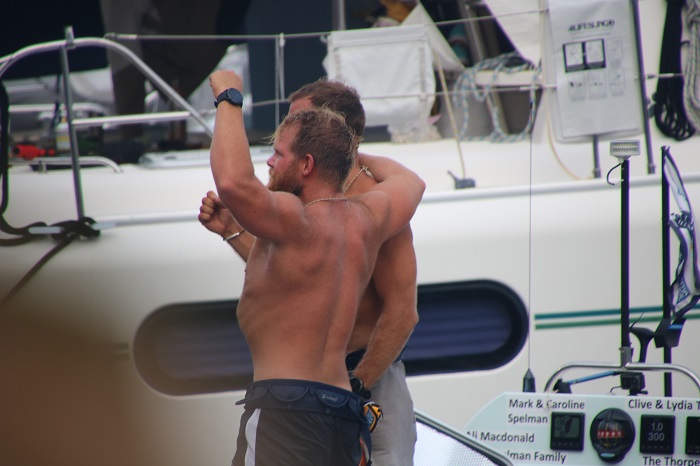 Seeing the teams greet family was quite moving. Most were overcome by emotion as soon as they stepped on the dock, reunited with loved ones, wives and babies that they had not seen for months.
Seeing the teams greet family was quite moving. Most were overcome by emotion as soon as they stepped on the dock, reunited with loved ones, wives and babies that they had not seen for months. 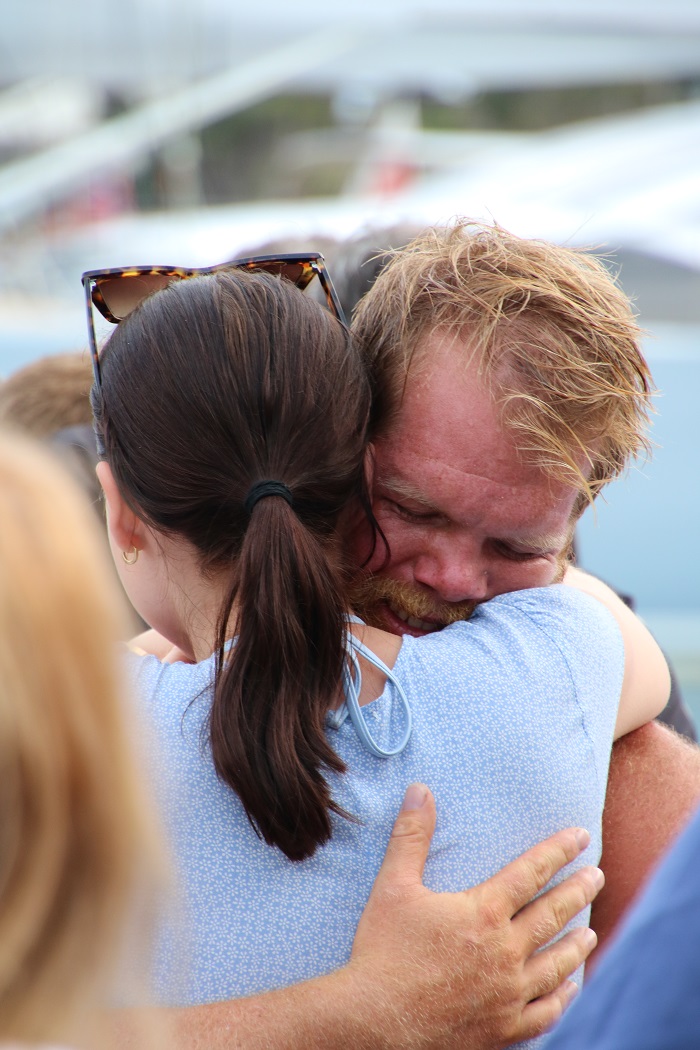 Every moment of each team’s arrival was captured from every angle.
Every moment of each team’s arrival was captured from every angle.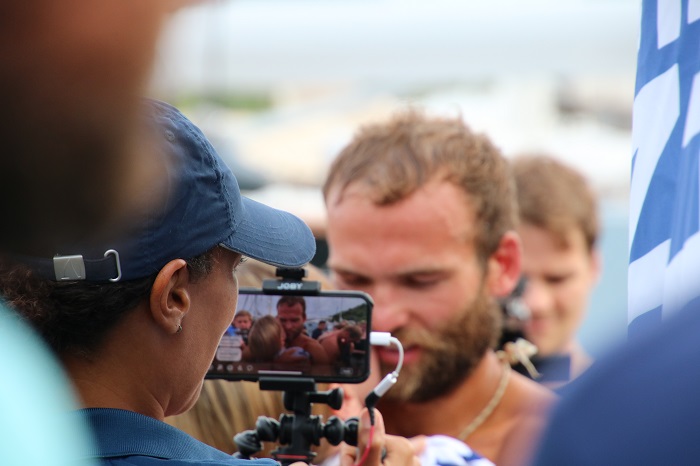 These boats are all nearly identical, only longer or shorter depending on the number of rowing stations. I am told that some of the boats are shipped home after the race and some sold here in Antigua. I doubt that they are used more than once by many individual teams. “Hey guys, that was fun, wana row back?”
These boats are all nearly identical, only longer or shorter depending on the number of rowing stations. I am told that some of the boats are shipped home after the race and some sold here in Antigua. I doubt that they are used more than once by many individual teams. “Hey guys, that was fun, wana row back?” According to the official site, some facts…
According to the official site, some facts…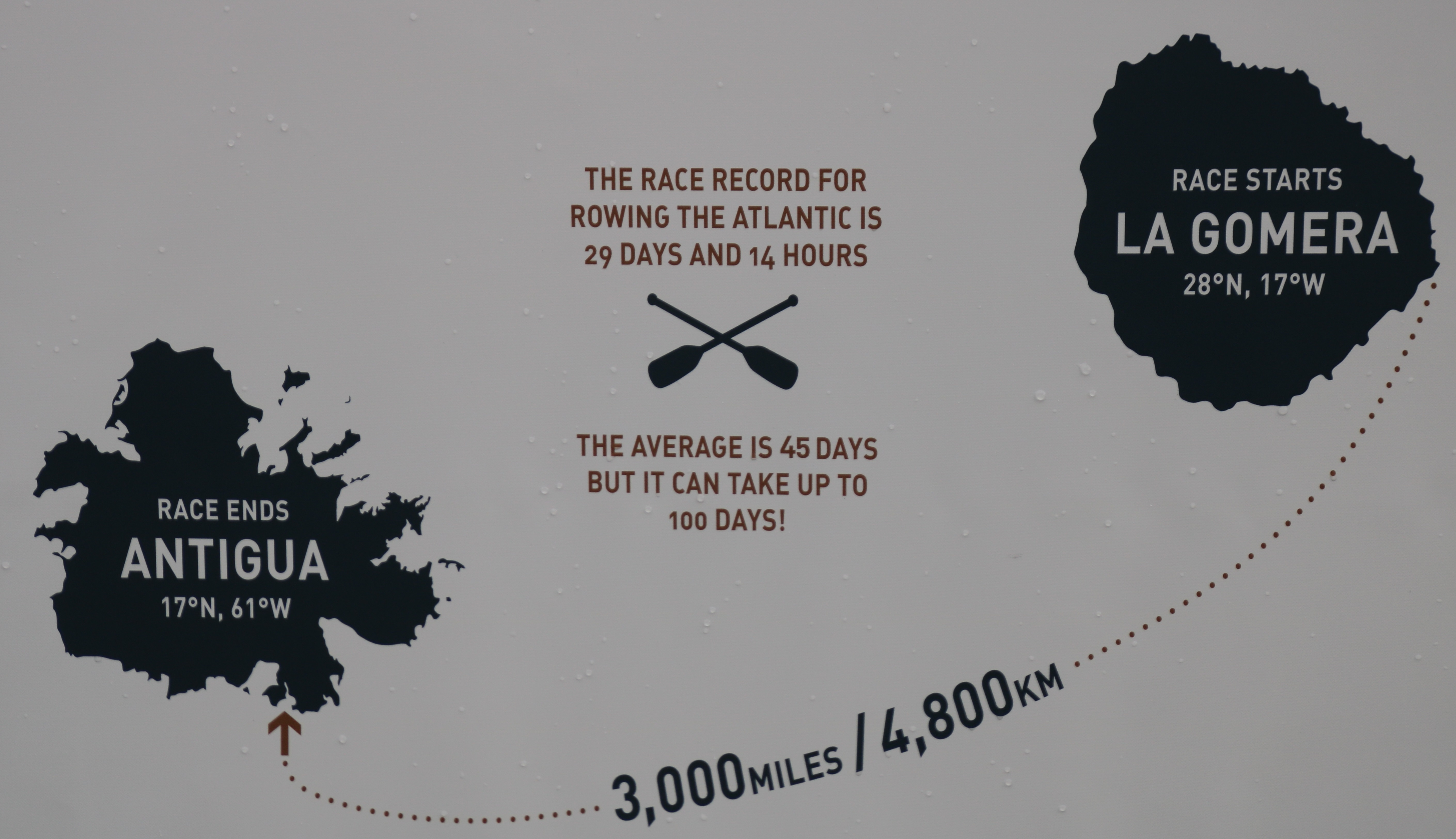 This short video gives a good feel for what the arrival was like and highlights from some of the races. There is no doubt about it, this is indeed “The Worlds Toughest Row”.
This short video gives a good feel for what the arrival was like and highlights from some of the races. There is no doubt about it, this is indeed “The Worlds Toughest Row”. Come to Antigua and find out for yourself.
Come to Antigua and find out for yourself. High up on the ridge, overlooking the dockyard, the strong winds were really whipping. Seeing the tall grass swaying in the breeze was beautiful.
High up on the ridge, overlooking the dockyard, the strong winds were really whipping. Seeing the tall grass swaying in the breeze was beautiful.  He talked about the history of some of the building, each with their own story.
He talked about the history of some of the building, each with their own story. 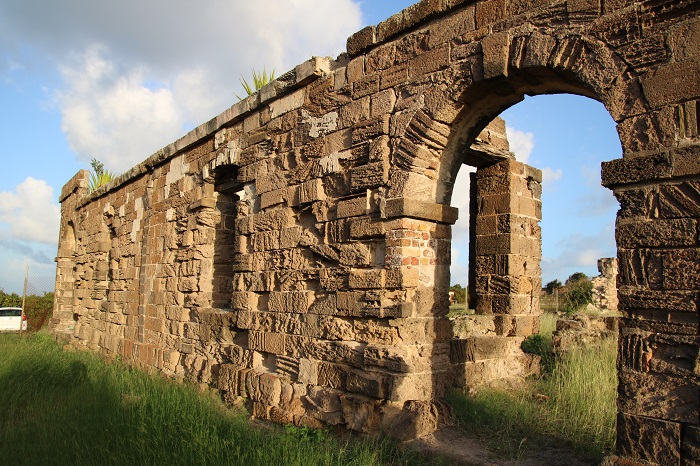 His description of the ruins and life in that era gave us a good feel for what life must have been like here so many years ago.
His description of the ruins and life in that era gave us a good feel for what life must have been like here so many years ago. 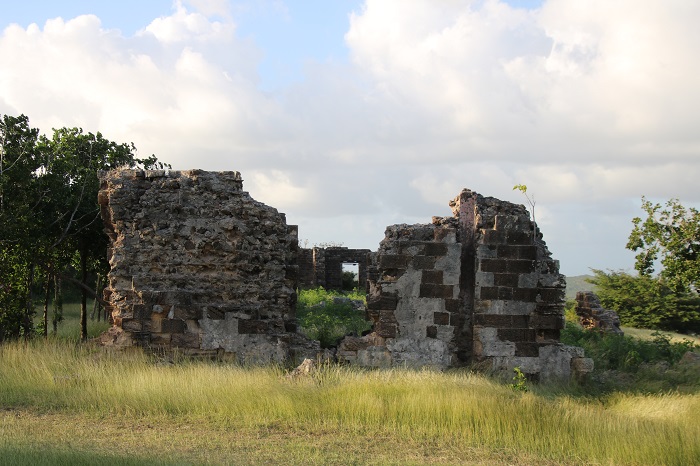 I’ve mentioned this in a past post, but from the bluff, you could see Eric Clapton’s compound way down below.
I’ve mentioned this in a past post, but from the bluff, you could see Eric Clapton’s compound way down below.  After the tour, just as it was getting dark, our group headed back to town. Interestingly, here in the Caribbean, dusk is very short and sunset to pitch dark is quick, perhaps about 30 minutes. Not a lot of twilight in these parts.
After the tour, just as it was getting dark, our group headed back to town. Interestingly, here in the Caribbean, dusk is very short and sunset to pitch dark is quick, perhaps about 30 minutes. Not a lot of twilight in these parts.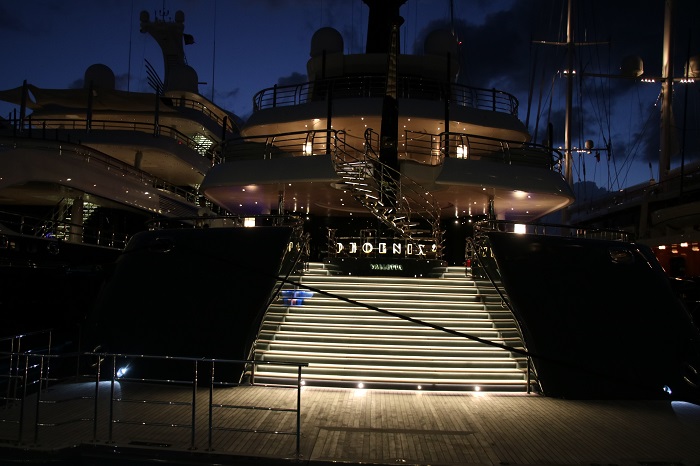 Phoenix 2 was launched for Jan Kulczyk in 2010, then the richest guy in Poland, for a reported $160,000,000. Unfortunately, under the category of “you can’t take it with you”,
Phoenix 2 was launched for Jan Kulczyk in 2010, then the richest guy in Poland, for a reported $160,000,000. Unfortunately, under the category of “you can’t take it with you”, 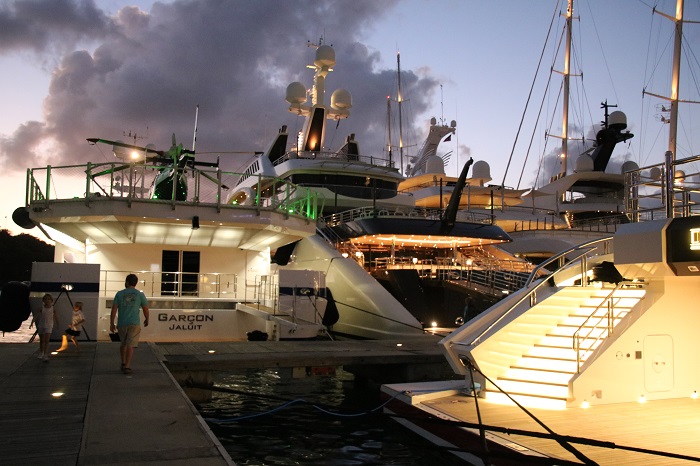 This recent addition to the relentless need to “keep up with the Joneses” world of the uber-rich has only happened in the last few years but I am sure that you will agree that if you were forced to cram all your stuff into a single yacht it would be quite annoying. “Garson, can you PLEASE get Dimitri’s chopper off of the sundeck? I’d like to work on my tan.”
This recent addition to the relentless need to “keep up with the Joneses” world of the uber-rich has only happened in the last few years but I am sure that you will agree that if you were forced to cram all your stuff into a single yacht it would be quite annoying. “Garson, can you PLEASE get Dimitri’s chopper off of the sundeck? I’d like to work on my tan.”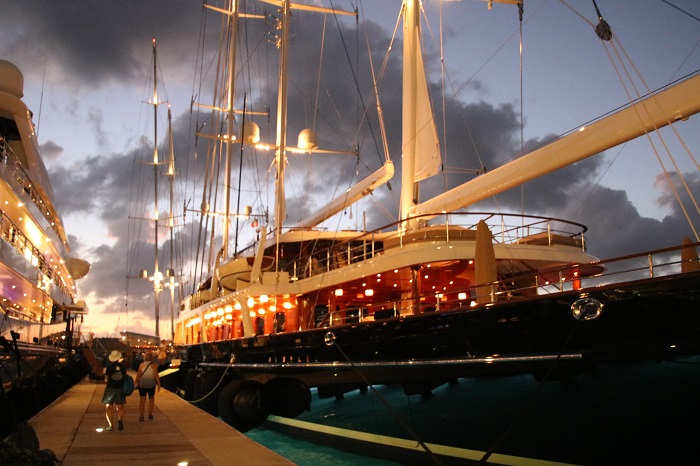 Across the dock is Phoenix which is so much larger in displacement in spite of being about the same length.
Across the dock is Phoenix which is so much larger in displacement in spite of being about the same length. 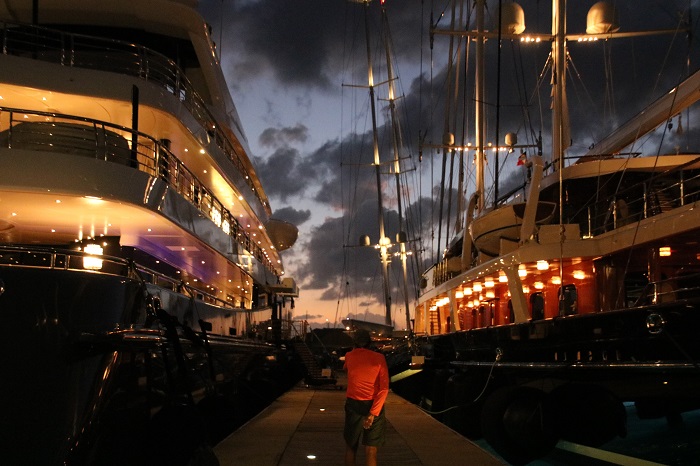 Everywhere you look, something more expensive looking than you’d expect. How about these boarding ladders and most with a intercom to announce yourself. “Can I trouble you for a bit of Grey Poupon?” “No, go away!”
Everywhere you look, something more expensive looking than you’d expect. How about these boarding ladders and most with a intercom to announce yourself. “Can I trouble you for a bit of Grey Poupon?” “No, go away!”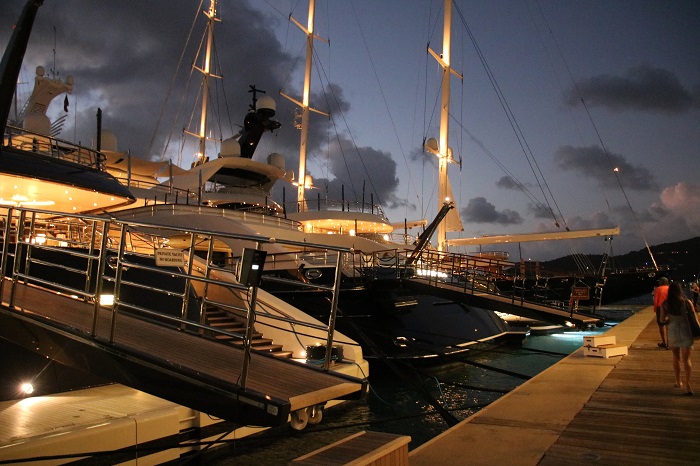 I guess that’s it for now and as I continue to recover from my ill advised sampling out of the local fruits, I expect that the crew and owners on these huge yachts of wealth know better.
I guess that’s it for now and as I continue to recover from my ill advised sampling out of the local fruits, I expect that the crew and owners on these huge yachts of wealth know better.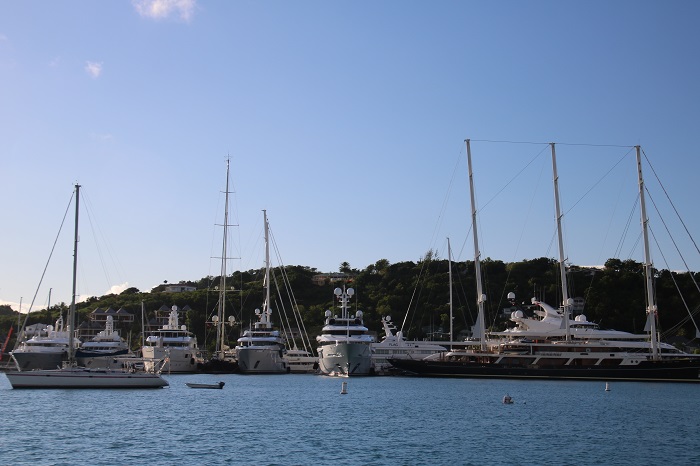 She is EOS, one of the largest sailing yachts in the world, at over 300′. She’s so large that they had to bring her into the harbor backwards, in the dark, because she is too large to turn around in the basin. She’s owned by
She is EOS, one of the largest sailing yachts in the world, at over 300′. She’s so large that they had to bring her into the harbor backwards, in the dark, because she is too large to turn around in the basin. She’s owned by  I guess that the big question is why do we spend so much time, MONEY and energy on boats when they cause such heartache.
I guess that the big question is why do we spend so much time, MONEY and energy on boats when they cause such heartache.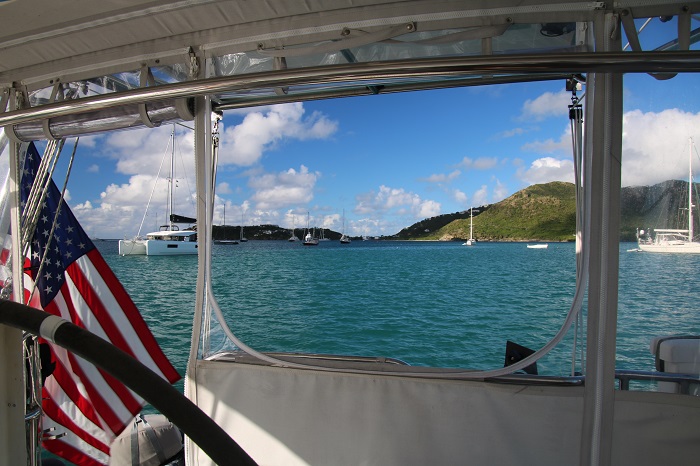 And, as if this view isn’t spectacular enough, I expect that a passing shower will show up in the next hour or so and leave a beautiful double rainbow in it’s wake.
And, as if this view isn’t spectacular enough, I expect that a passing shower will show up in the next hour or so and leave a beautiful double rainbow in it’s wake.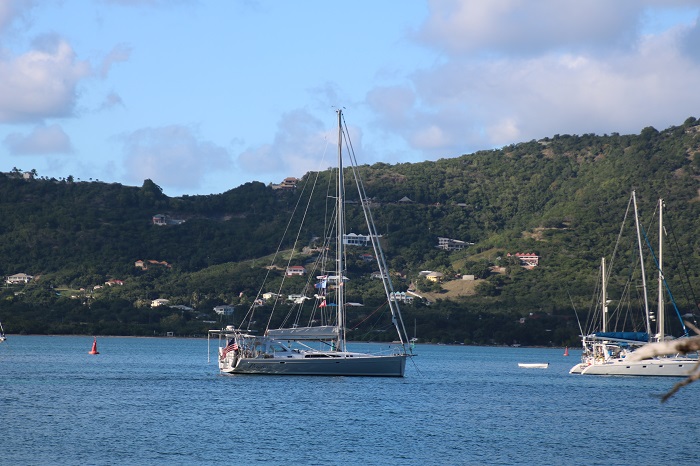 Break out another thousand? I’d prefer not to think about all that, I’ll just enjoy the view.
Break out another thousand? I’d prefer not to think about all that, I’ll just enjoy the view.